Careers Australia CHCPOL003: Alternative Nursing Therapies Research
VerifiedAdded on 2023/01/11
|21
|3888
|34
Report
AI Summary
This report explores the integration of alternative therapies into nursing practice. The research begins with an introduction to alternative and complementary therapies, differentiating them from traditional medical approaches. It examines the factors influencing the use of these therapies, including economic considerations, beliefs in effectiveness, and accessibility. The report delves into specific examples like acupuncture, homeopathy, and chiropractic, providing a literature review of their effectiveness and viability. The methodology section outlines the research approach, design, and data collection methods, which included a survey of nursing home residents. The data analysis section presents the findings, including age demographics, length of association with the nursing home, and satisfaction levels with current treatments. The report concludes by linking the findings to the research objectives, offering recommendations, and acknowledging research limitations. The overall aim is to assess the potential for incorporating alternative therapies to enhance nursing care and improve patient outcomes.
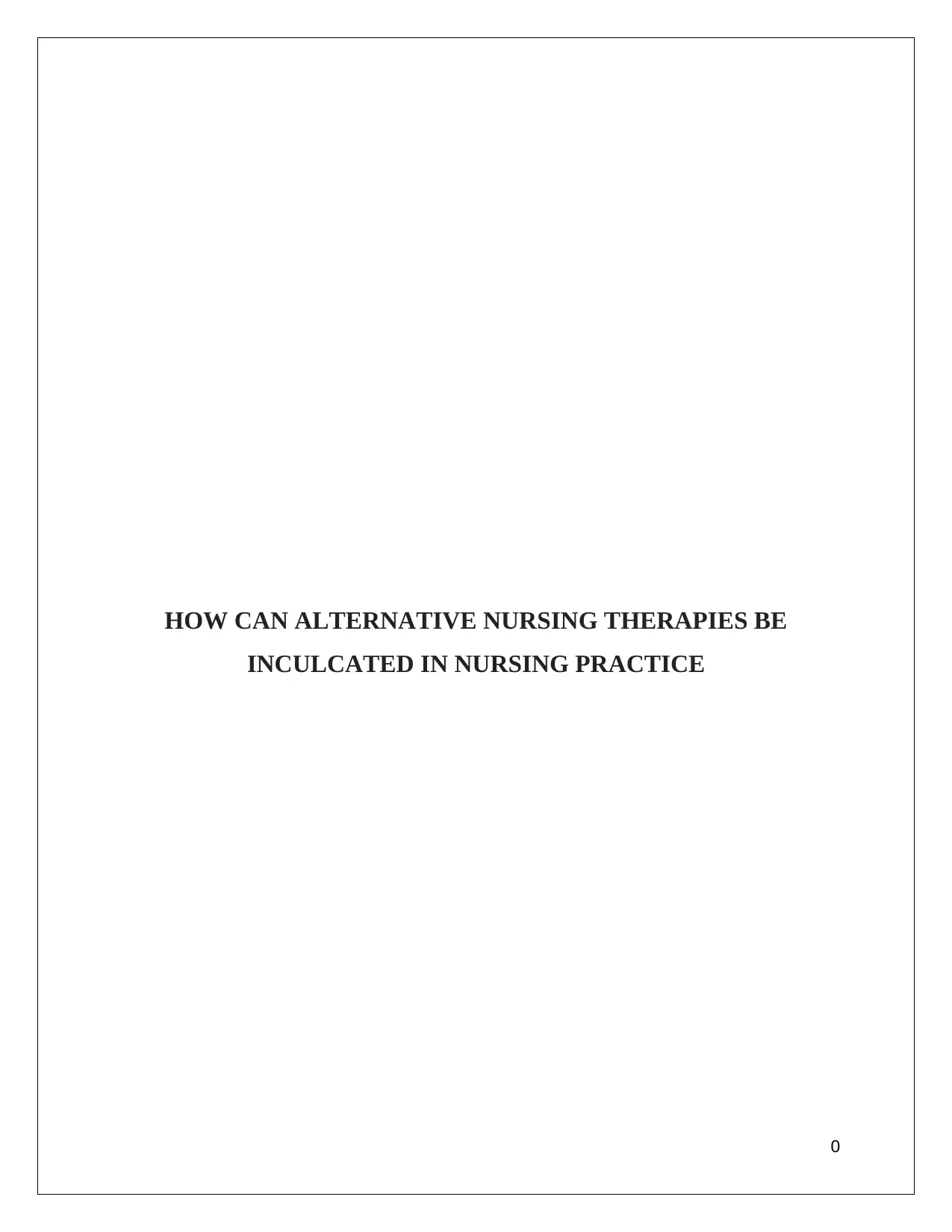
HOW CAN ALTERNATIVE NURSING THERAPIES BE
INCULCATED IN NURSING PRACTICE
0
INCULCATED IN NURSING PRACTICE
0
Secure Best Marks with AI Grader
Need help grading? Try our AI Grader for instant feedback on your assignments.
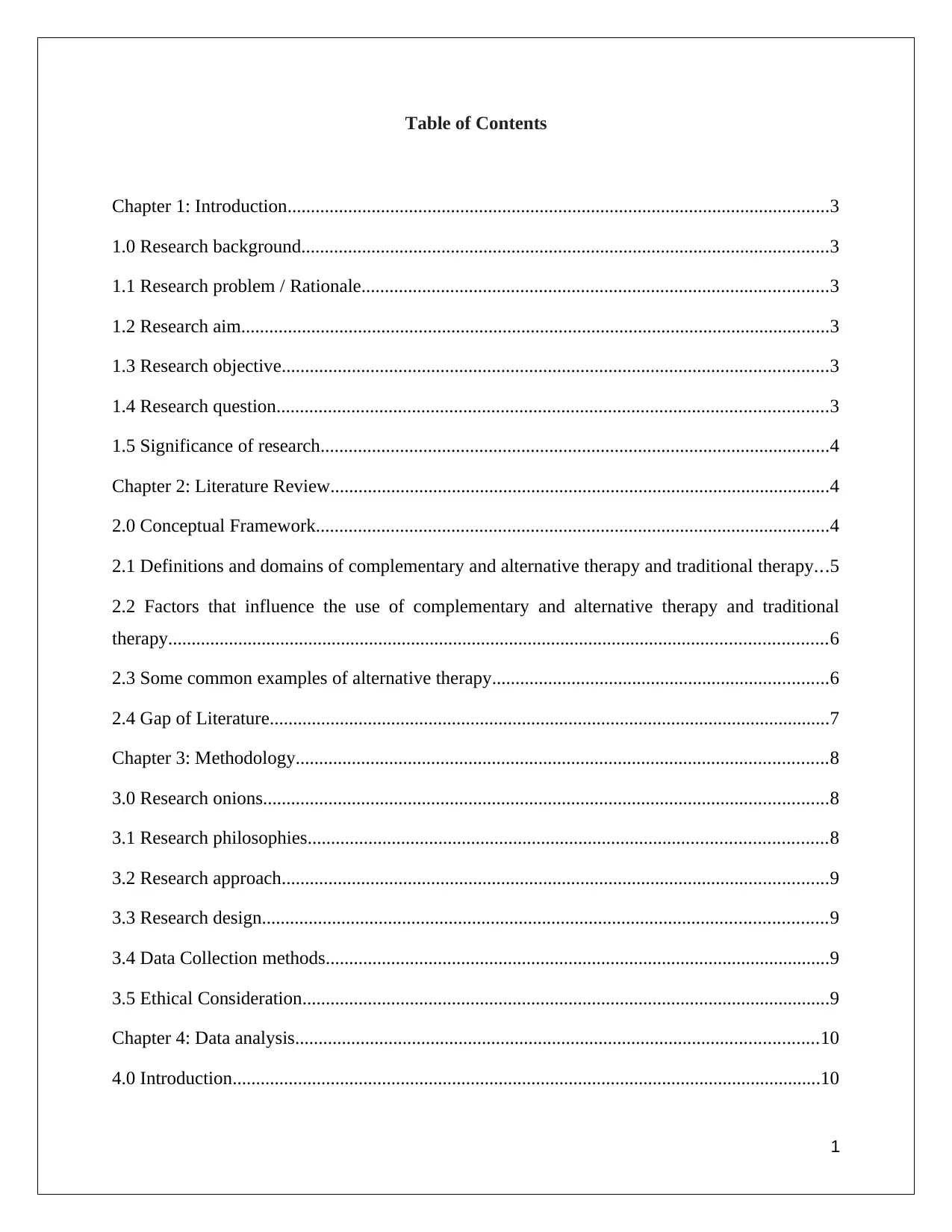
Table of Contents
Chapter 1: Introduction....................................................................................................................3
1.0 Research background.................................................................................................................3
1.1 Research problem / Rationale....................................................................................................3
1.2 Research aim..............................................................................................................................3
1.3 Research objective.....................................................................................................................3
1.4 Research question......................................................................................................................3
1.5 Significance of research.............................................................................................................4
Chapter 2: Literature Review...........................................................................................................4
2.0 Conceptual Framework..............................................................................................................4
2.1 Definitions and domains of complementary and alternative therapy and traditional therapy...5
2.2 Factors that influence the use of complementary and alternative therapy and traditional
therapy.............................................................................................................................................6
2.3 Some common examples of alternative therapy........................................................................6
2.4 Gap of Literature........................................................................................................................7
Chapter 3: Methodology..................................................................................................................8
3.0 Research onions.........................................................................................................................8
3.1 Research philosophies...............................................................................................................8
3.2 Research approach.....................................................................................................................9
3.3 Research design.........................................................................................................................9
3.4 Data Collection methods............................................................................................................9
3.5 Ethical Consideration.................................................................................................................9
Chapter 4: Data analysis................................................................................................................10
4.0 Introduction..............................................................................................................................10
1
Chapter 1: Introduction....................................................................................................................3
1.0 Research background.................................................................................................................3
1.1 Research problem / Rationale....................................................................................................3
1.2 Research aim..............................................................................................................................3
1.3 Research objective.....................................................................................................................3
1.4 Research question......................................................................................................................3
1.5 Significance of research.............................................................................................................4
Chapter 2: Literature Review...........................................................................................................4
2.0 Conceptual Framework..............................................................................................................4
2.1 Definitions and domains of complementary and alternative therapy and traditional therapy...5
2.2 Factors that influence the use of complementary and alternative therapy and traditional
therapy.............................................................................................................................................6
2.3 Some common examples of alternative therapy........................................................................6
2.4 Gap of Literature........................................................................................................................7
Chapter 3: Methodology..................................................................................................................8
3.0 Research onions.........................................................................................................................8
3.1 Research philosophies...............................................................................................................8
3.2 Research approach.....................................................................................................................9
3.3 Research design.........................................................................................................................9
3.4 Data Collection methods............................................................................................................9
3.5 Ethical Consideration.................................................................................................................9
Chapter 4: Data analysis................................................................................................................10
4.0 Introduction..............................................................................................................................10
1
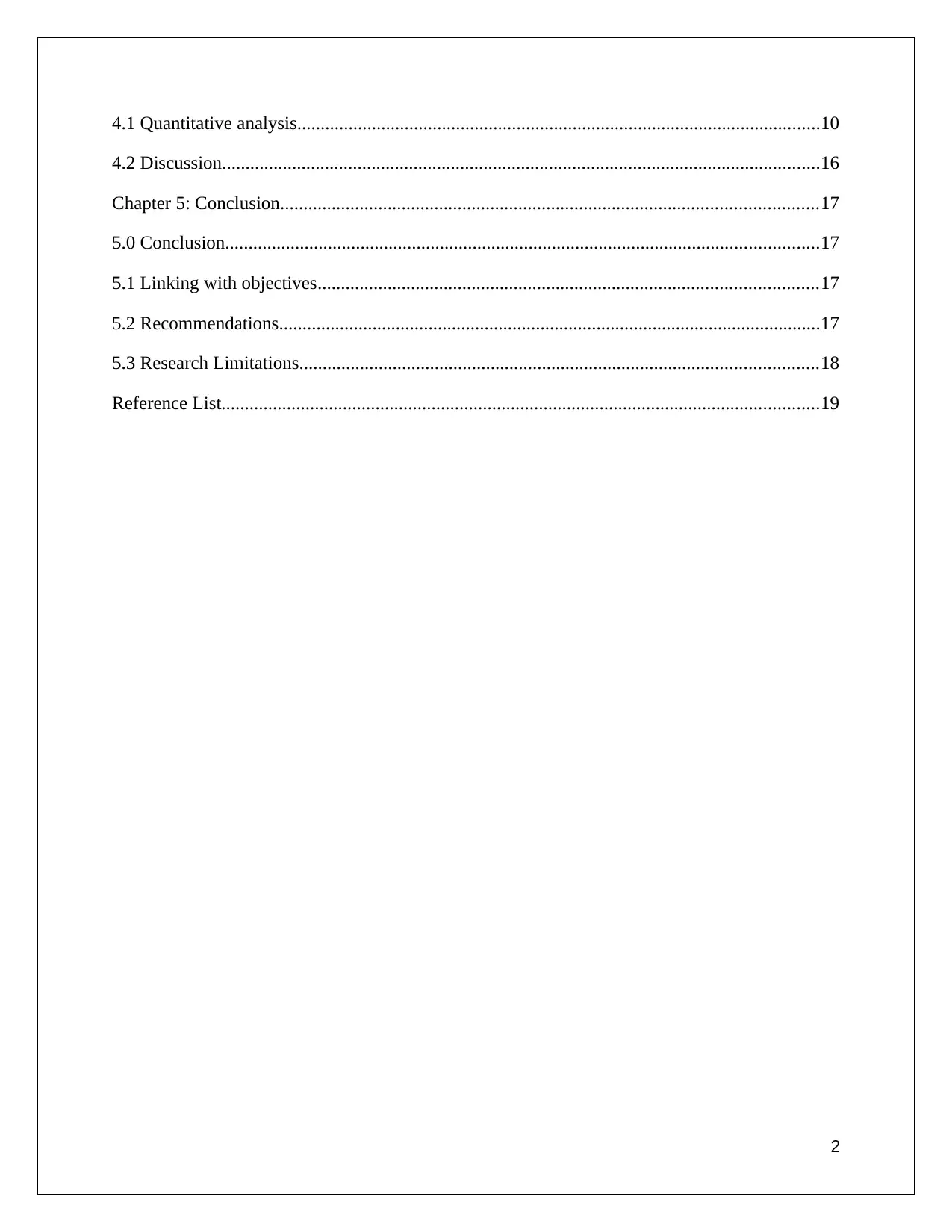
4.1 Quantitative analysis................................................................................................................10
4.2 Discussion................................................................................................................................16
Chapter 5: Conclusion...................................................................................................................17
5.0 Conclusion...............................................................................................................................17
5.1 Linking with objectives...........................................................................................................17
5.2 Recommendations....................................................................................................................17
5.3 Research Limitations...............................................................................................................18
Reference List................................................................................................................................19
2
4.2 Discussion................................................................................................................................16
Chapter 5: Conclusion...................................................................................................................17
5.0 Conclusion...............................................................................................................................17
5.1 Linking with objectives...........................................................................................................17
5.2 Recommendations....................................................................................................................17
5.3 Research Limitations...............................................................................................................18
Reference List................................................................................................................................19
2
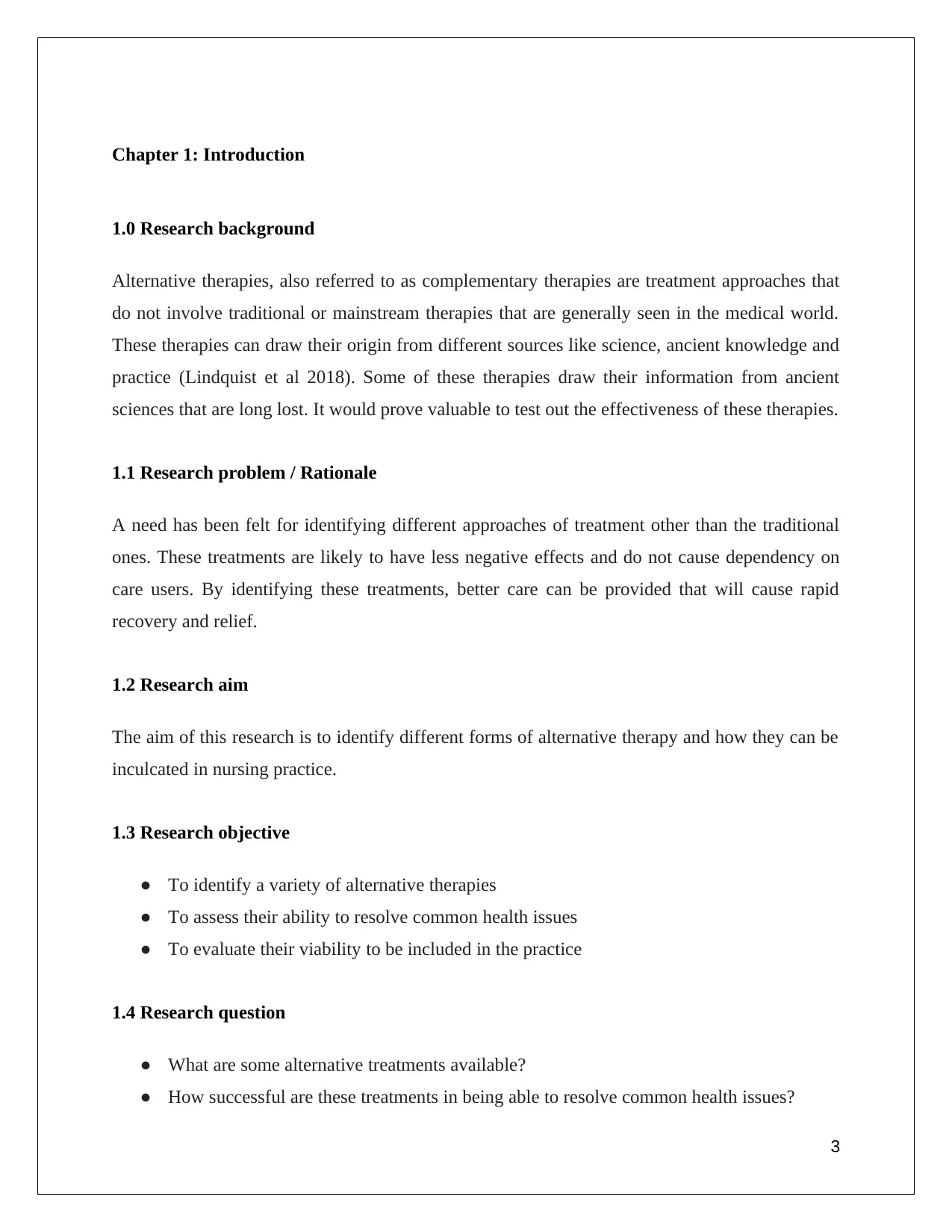
Chapter 1: Introduction
1.0 Research background
Alternative therapies, also referred to as complementary therapies are treatment approaches that
do not involve traditional or mainstream therapies that are generally seen in the medical world.
These therapies can draw their origin from different sources like science, ancient knowledge and
practice (Lindquist et al 2018). Some of these therapies draw their information from ancient
sciences that are long lost. It would prove valuable to test out the effectiveness of these therapies.
1.1 Research problem / Rationale
A need has been felt for identifying different approaches of treatment other than the traditional
ones. These treatments are likely to have less negative effects and do not cause dependency on
care users. By identifying these treatments, better care can be provided that will cause rapid
recovery and relief.
1.2 Research aim
The aim of this research is to identify different forms of alternative therapy and how they can be
inculcated in nursing practice.
1.3 Research objective
● To identify a variety of alternative therapies
● To assess their ability to resolve common health issues
● To evaluate their viability to be included in the practice
1.4 Research question
● What are some alternative treatments available?
● How successful are these treatments in being able to resolve common health issues?
3
1.0 Research background
Alternative therapies, also referred to as complementary therapies are treatment approaches that
do not involve traditional or mainstream therapies that are generally seen in the medical world.
These therapies can draw their origin from different sources like science, ancient knowledge and
practice (Lindquist et al 2018). Some of these therapies draw their information from ancient
sciences that are long lost. It would prove valuable to test out the effectiveness of these therapies.
1.1 Research problem / Rationale
A need has been felt for identifying different approaches of treatment other than the traditional
ones. These treatments are likely to have less negative effects and do not cause dependency on
care users. By identifying these treatments, better care can be provided that will cause rapid
recovery and relief.
1.2 Research aim
The aim of this research is to identify different forms of alternative therapy and how they can be
inculcated in nursing practice.
1.3 Research objective
● To identify a variety of alternative therapies
● To assess their ability to resolve common health issues
● To evaluate their viability to be included in the practice
1.4 Research question
● What are some alternative treatments available?
● How successful are these treatments in being able to resolve common health issues?
3
Secure Best Marks with AI Grader
Need help grading? Try our AI Grader for instant feedback on your assignments.
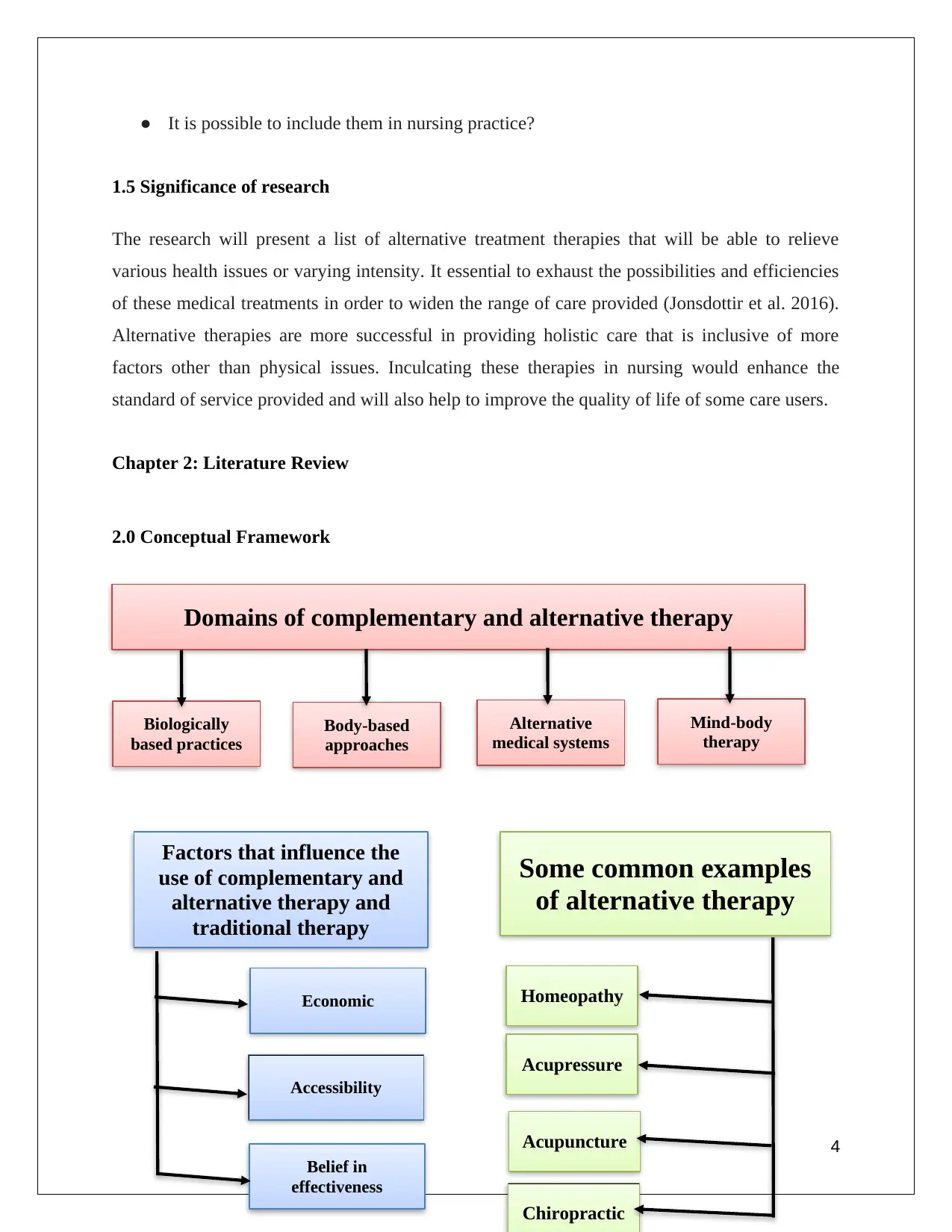
● It is possible to include them in nursing practice?
1.5 Significance of research
The research will present a list of alternative treatment therapies that will be able to relieve
various health issues or varying intensity. It essential to exhaust the possibilities and efficiencies
of these medical treatments in order to widen the range of care provided (Jonsdottir et al. 2016).
Alternative therapies are more successful in providing holistic care that is inclusive of more
factors other than physical issues. Inculcating these therapies in nursing would enhance the
standard of service provided and will also help to improve the quality of life of some care users.
Chapter 2: Literature Review
2.0 Conceptual Framework
4
Economic
Biologically
based practices
Domains of complementary and alternative therapy
Body-based
approaches
Mind-body
therapy
Alternative
medical systems
Accessibility
Belief in
effectiveness
Factors that influence the
use of complementary and
alternative therapy and
traditional therapy
Some common examples
of alternative therapy
Homeopathy
Acupressure
Acupuncture
Chiropractic
1.5 Significance of research
The research will present a list of alternative treatment therapies that will be able to relieve
various health issues or varying intensity. It essential to exhaust the possibilities and efficiencies
of these medical treatments in order to widen the range of care provided (Jonsdottir et al. 2016).
Alternative therapies are more successful in providing holistic care that is inclusive of more
factors other than physical issues. Inculcating these therapies in nursing would enhance the
standard of service provided and will also help to improve the quality of life of some care users.
Chapter 2: Literature Review
2.0 Conceptual Framework
4
Economic
Biologically
based practices
Domains of complementary and alternative therapy
Body-based
approaches
Mind-body
therapy
Alternative
medical systems
Accessibility
Belief in
effectiveness
Factors that influence the
use of complementary and
alternative therapy and
traditional therapy
Some common examples
of alternative therapy
Homeopathy
Acupressure
Acupuncture
Chiropractic
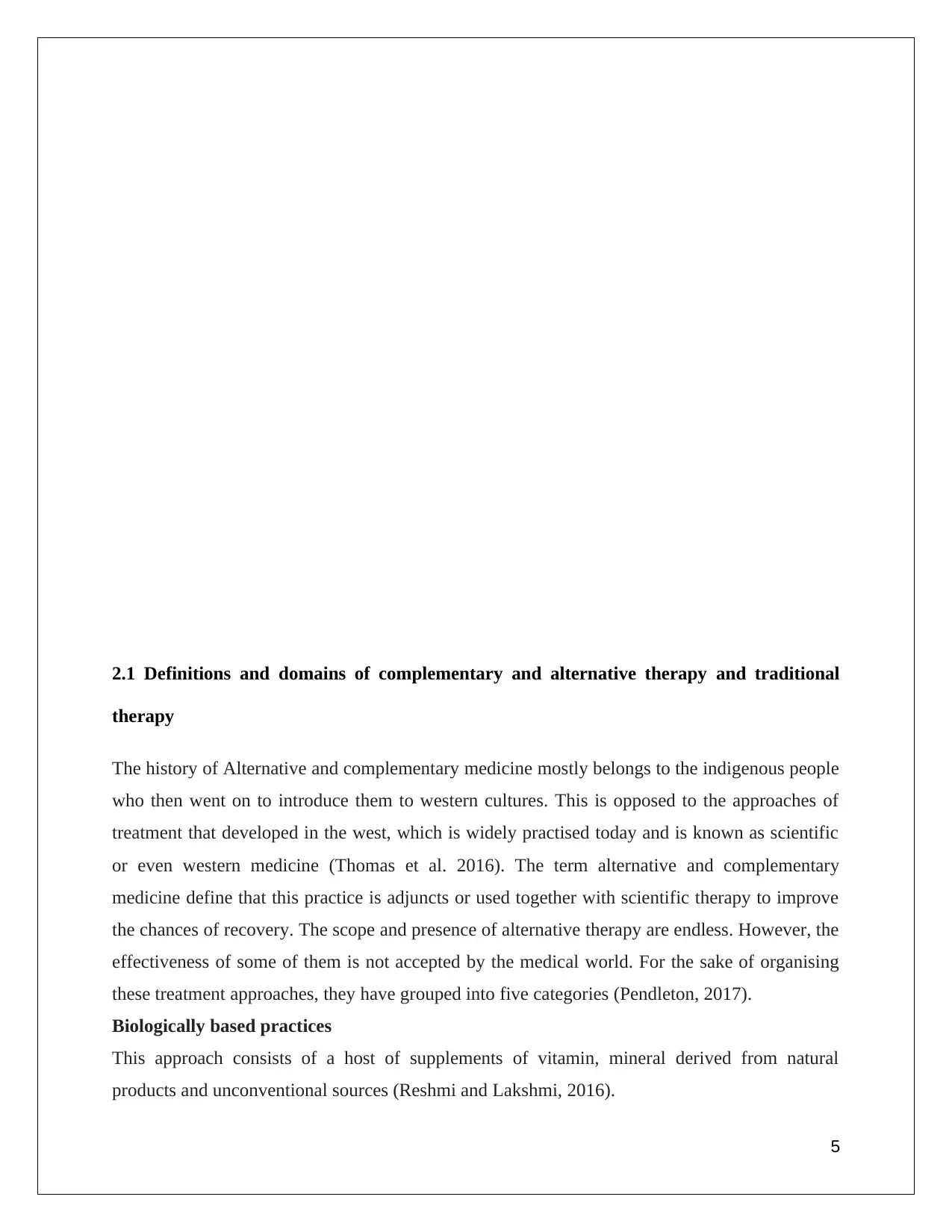
2.1 Definitions and domains of complementary and alternative therapy and traditional
therapy
The history of Alternative and complementary medicine mostly belongs to the indigenous people
who then went on to introduce them to western cultures. This is opposed to the approaches of
treatment that developed in the west, which is widely practised today and is known as scientific
or even western medicine (Thomas et al. 2016). The term alternative and complementary
medicine define that this practice is adjuncts or used together with scientific therapy to improve
the chances of recovery. The scope and presence of alternative therapy are endless. However, the
effectiveness of some of them is not accepted by the medical world. For the sake of organising
these treatment approaches, they have grouped into five categories (Pendleton, 2017).
Biologically based practices
This approach consists of a host of supplements of vitamin, mineral derived from natural
products and unconventional sources (Reshmi and Lakshmi, 2016).
5
therapy
The history of Alternative and complementary medicine mostly belongs to the indigenous people
who then went on to introduce them to western cultures. This is opposed to the approaches of
treatment that developed in the west, which is widely practised today and is known as scientific
or even western medicine (Thomas et al. 2016). The term alternative and complementary
medicine define that this practice is adjuncts or used together with scientific therapy to improve
the chances of recovery. The scope and presence of alternative therapy are endless. However, the
effectiveness of some of them is not accepted by the medical world. For the sake of organising
these treatment approaches, they have grouped into five categories (Pendleton, 2017).
Biologically based practices
This approach consists of a host of supplements of vitamin, mineral derived from natural
products and unconventional sources (Reshmi and Lakshmi, 2016).
5
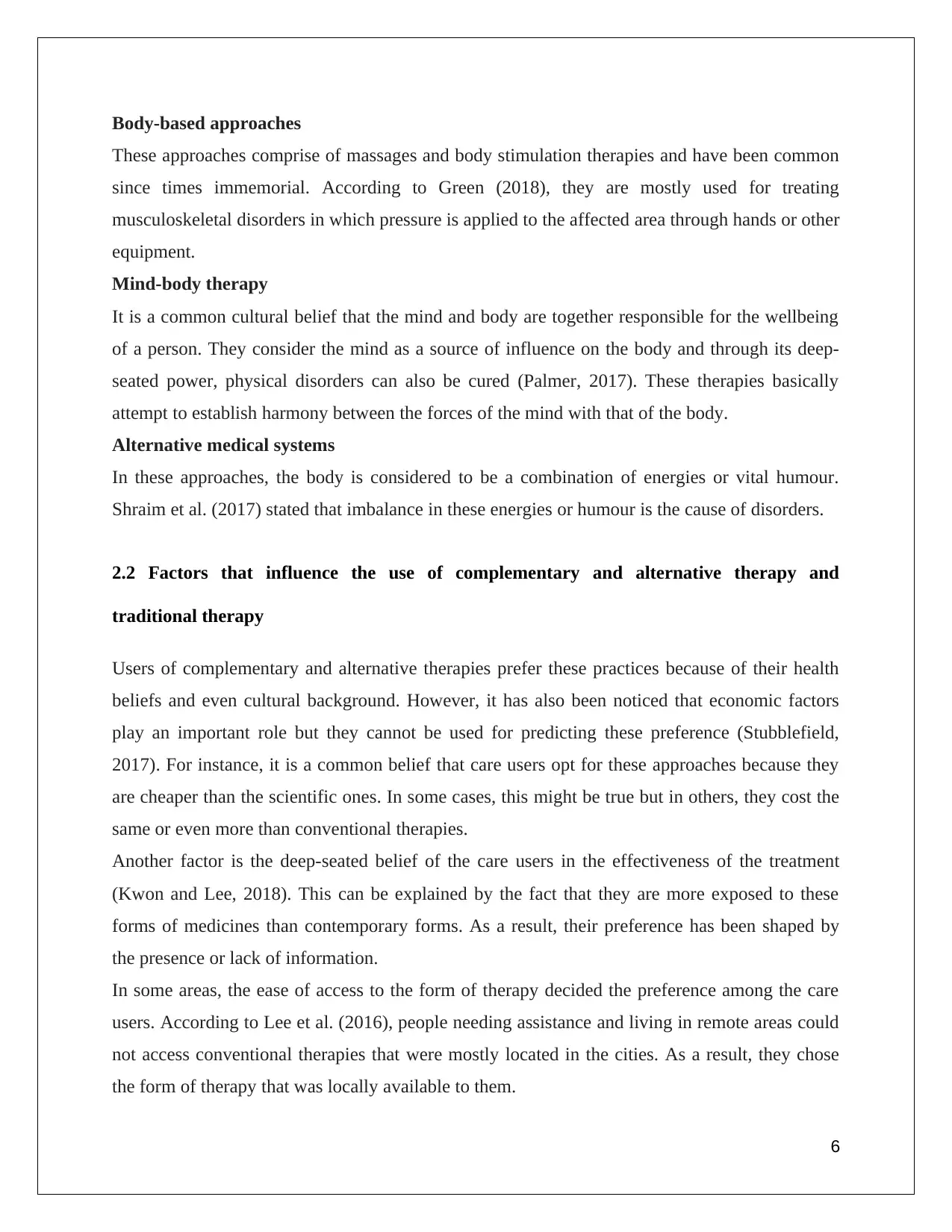
Body-based approaches
These approaches comprise of massages and body stimulation therapies and have been common
since times immemorial. According to Green (2018), they are mostly used for treating
musculoskeletal disorders in which pressure is applied to the affected area through hands or other
equipment.
Mind-body therapy
It is a common cultural belief that the mind and body are together responsible for the wellbeing
of a person. They consider the mind as a source of influence on the body and through its deep-
seated power, physical disorders can also be cured (Palmer, 2017). These therapies basically
attempt to establish harmony between the forces of the mind with that of the body.
Alternative medical systems
In these approaches, the body is considered to be a combination of energies or vital humour.
Shraim et al. (2017) stated that imbalance in these energies or humour is the cause of disorders.
2.2 Factors that influence the use of complementary and alternative therapy and
traditional therapy
Users of complementary and alternative therapies prefer these practices because of their health
beliefs and even cultural background. However, it has also been noticed that economic factors
play an important role but they cannot be used for predicting these preference (Stubblefield,
2017). For instance, it is a common belief that care users opt for these approaches because they
are cheaper than the scientific ones. In some cases, this might be true but in others, they cost the
same or even more than conventional therapies.
Another factor is the deep-seated belief of the care users in the effectiveness of the treatment
(Kwon and Lee, 2018). This can be explained by the fact that they are more exposed to these
forms of medicines than contemporary forms. As a result, their preference has been shaped by
the presence or lack of information.
In some areas, the ease of access to the form of therapy decided the preference among the care
users. According to Lee et al. (2016), people needing assistance and living in remote areas could
not access conventional therapies that were mostly located in the cities. As a result, they chose
the form of therapy that was locally available to them.
6
These approaches comprise of massages and body stimulation therapies and have been common
since times immemorial. According to Green (2018), they are mostly used for treating
musculoskeletal disorders in which pressure is applied to the affected area through hands or other
equipment.
Mind-body therapy
It is a common cultural belief that the mind and body are together responsible for the wellbeing
of a person. They consider the mind as a source of influence on the body and through its deep-
seated power, physical disorders can also be cured (Palmer, 2017). These therapies basically
attempt to establish harmony between the forces of the mind with that of the body.
Alternative medical systems
In these approaches, the body is considered to be a combination of energies or vital humour.
Shraim et al. (2017) stated that imbalance in these energies or humour is the cause of disorders.
2.2 Factors that influence the use of complementary and alternative therapy and
traditional therapy
Users of complementary and alternative therapies prefer these practices because of their health
beliefs and even cultural background. However, it has also been noticed that economic factors
play an important role but they cannot be used for predicting these preference (Stubblefield,
2017). For instance, it is a common belief that care users opt for these approaches because they
are cheaper than the scientific ones. In some cases, this might be true but in others, they cost the
same or even more than conventional therapies.
Another factor is the deep-seated belief of the care users in the effectiveness of the treatment
(Kwon and Lee, 2018). This can be explained by the fact that they are more exposed to these
forms of medicines than contemporary forms. As a result, their preference has been shaped by
the presence or lack of information.
In some areas, the ease of access to the form of therapy decided the preference among the care
users. According to Lee et al. (2016), people needing assistance and living in remote areas could
not access conventional therapies that were mostly located in the cities. As a result, they chose
the form of therapy that was locally available to them.
6
Paraphrase This Document
Need a fresh take? Get an instant paraphrase of this document with our AI Paraphraser
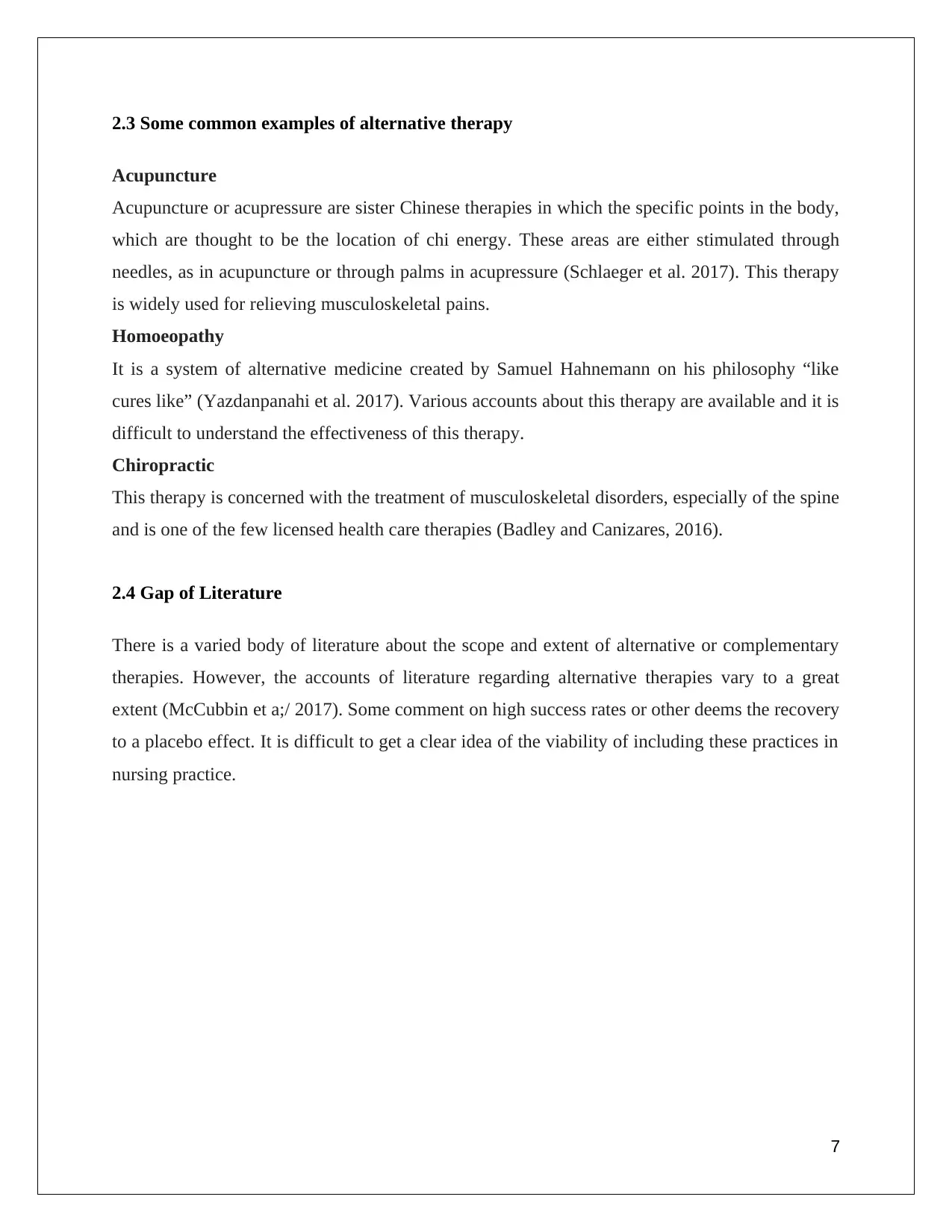
2.3 Some common examples of alternative therapy
Acupuncture
Acupuncture or acupressure are sister Chinese therapies in which the specific points in the body,
which are thought to be the location of chi energy. These areas are either stimulated through
needles, as in acupuncture or through palms in acupressure (Schlaeger et al. 2017). This therapy
is widely used for relieving musculoskeletal pains.
Homoeopathy
It is a system of alternative medicine created by Samuel Hahnemann on his philosophy “like
cures like” (Yazdanpanahi et al. 2017). Various accounts about this therapy are available and it is
difficult to understand the effectiveness of this therapy.
Chiropractic
This therapy is concerned with the treatment of musculoskeletal disorders, especially of the spine
and is one of the few licensed health care therapies (Badley and Canizares, 2016).
2.4 Gap of Literature
There is a varied body of literature about the scope and extent of alternative or complementary
therapies. However, the accounts of literature regarding alternative therapies vary to a great
extent (McCubbin et a;/ 2017). Some comment on high success rates or other deems the recovery
to a placebo effect. It is difficult to get a clear idea of the viability of including these practices in
nursing practice.
7
Acupuncture
Acupuncture or acupressure are sister Chinese therapies in which the specific points in the body,
which are thought to be the location of chi energy. These areas are either stimulated through
needles, as in acupuncture or through palms in acupressure (Schlaeger et al. 2017). This therapy
is widely used for relieving musculoskeletal pains.
Homoeopathy
It is a system of alternative medicine created by Samuel Hahnemann on his philosophy “like
cures like” (Yazdanpanahi et al. 2017). Various accounts about this therapy are available and it is
difficult to understand the effectiveness of this therapy.
Chiropractic
This therapy is concerned with the treatment of musculoskeletal disorders, especially of the spine
and is one of the few licensed health care therapies (Badley and Canizares, 2016).
2.4 Gap of Literature
There is a varied body of literature about the scope and extent of alternative or complementary
therapies. However, the accounts of literature regarding alternative therapies vary to a great
extent (McCubbin et a;/ 2017). Some comment on high success rates or other deems the recovery
to a placebo effect. It is difficult to get a clear idea of the viability of including these practices in
nursing practice.
7
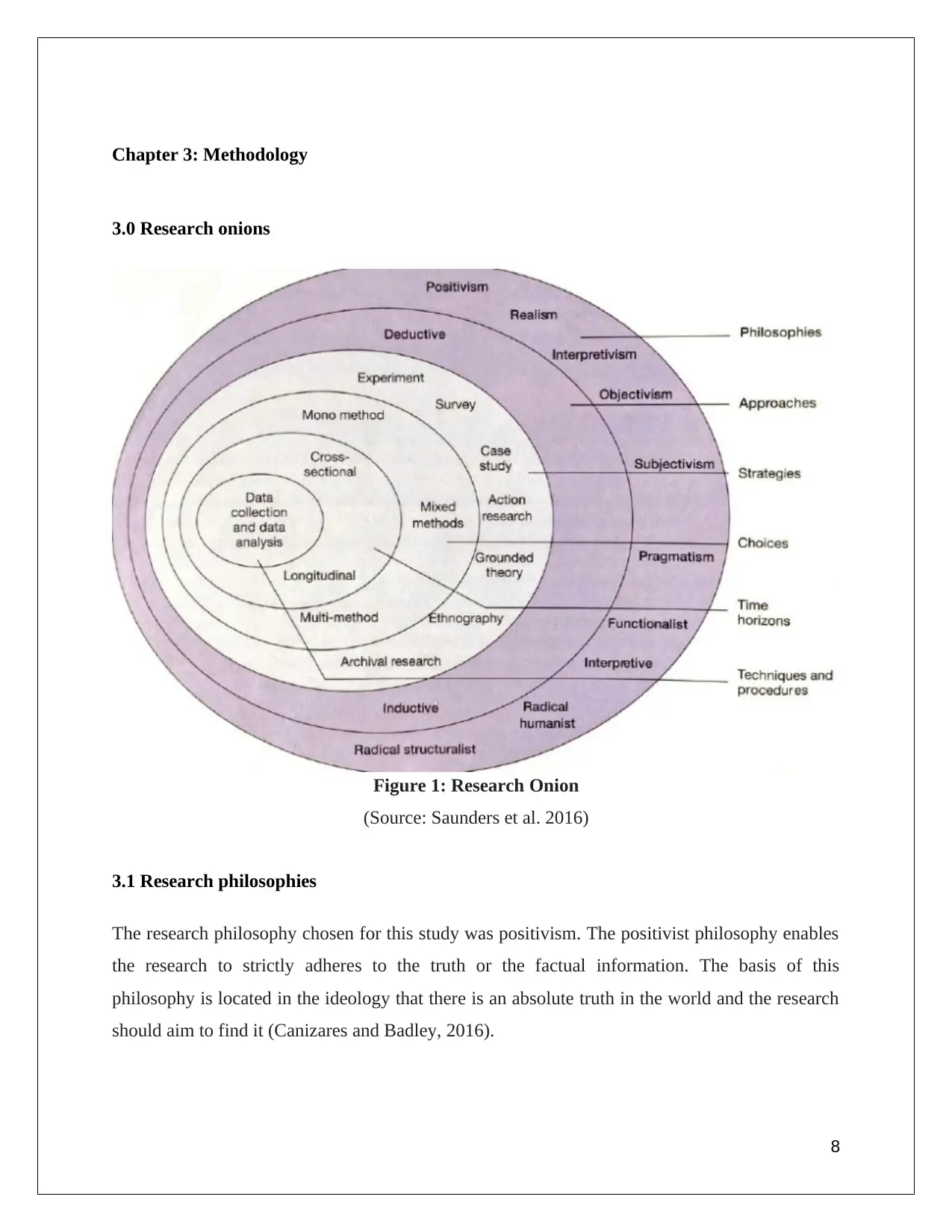
Chapter 3: Methodology
3.0 Research onions
Figure 1: Research Onion
(Source: Saunders et al. 2016)
3.1 Research philosophies
The research philosophy chosen for this study was positivism. The positivist philosophy enables
the research to strictly adheres to the truth or the factual information. The basis of this
philosophy is located in the ideology that there is an absolute truth in the world and the research
should aim to find it (Canizares and Badley, 2016).
8
3.0 Research onions
Figure 1: Research Onion
(Source: Saunders et al. 2016)
3.1 Research philosophies
The research philosophy chosen for this study was positivism. The positivist philosophy enables
the research to strictly adheres to the truth or the factual information. The basis of this
philosophy is located in the ideology that there is an absolute truth in the world and the research
should aim to find it (Canizares and Badley, 2016).
8
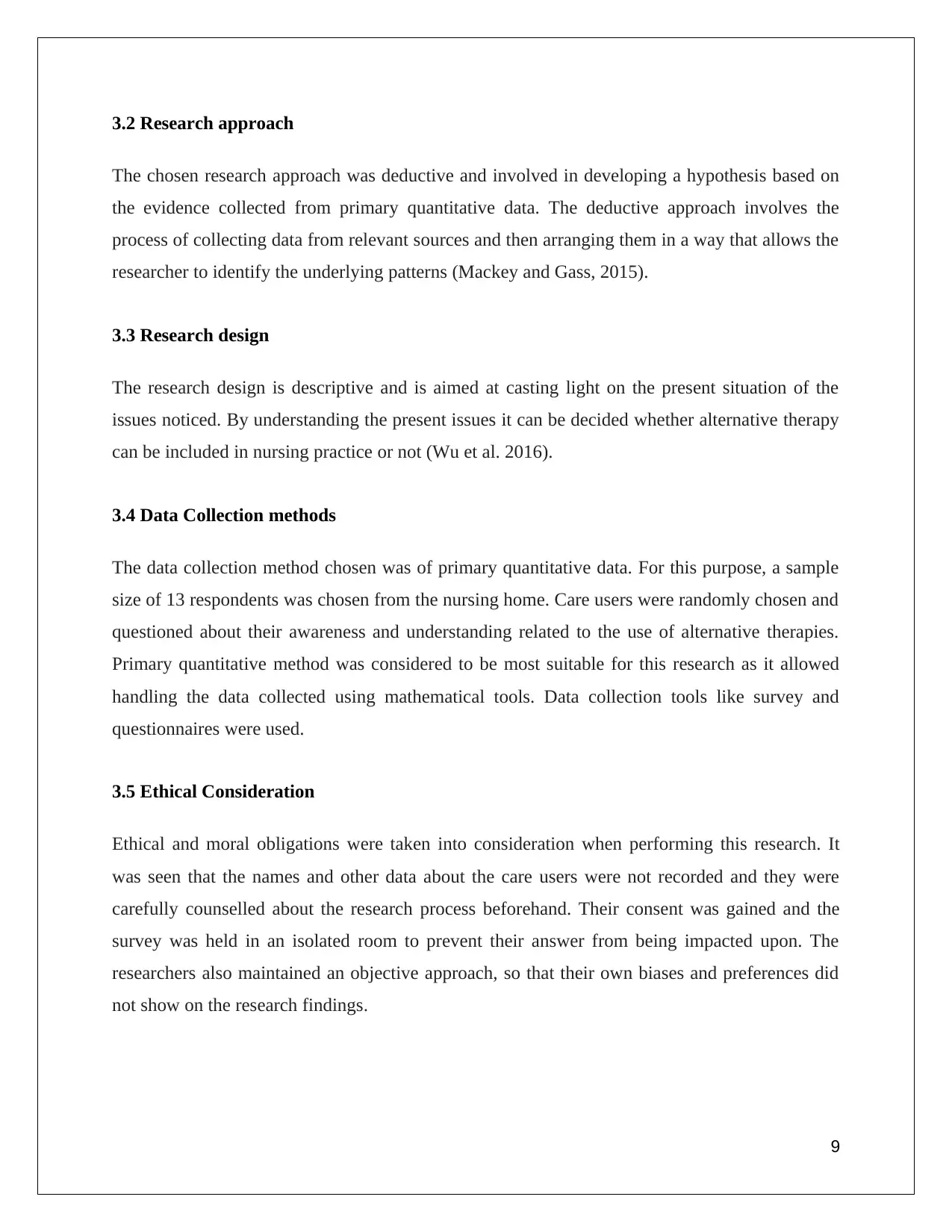
3.2 Research approach
The chosen research approach was deductive and involved in developing a hypothesis based on
the evidence collected from primary quantitative data. The deductive approach involves the
process of collecting data from relevant sources and then arranging them in a way that allows the
researcher to identify the underlying patterns (Mackey and Gass, 2015).
3.3 Research design
The research design is descriptive and is aimed at casting light on the present situation of the
issues noticed. By understanding the present issues it can be decided whether alternative therapy
can be included in nursing practice or not (Wu et al. 2016).
3.4 Data Collection methods
The data collection method chosen was of primary quantitative data. For this purpose, a sample
size of 13 respondents was chosen from the nursing home. Care users were randomly chosen and
questioned about their awareness and understanding related to the use of alternative therapies.
Primary quantitative method was considered to be most suitable for this research as it allowed
handling the data collected using mathematical tools. Data collection tools like survey and
questionnaires were used.
3.5 Ethical Consideration
Ethical and moral obligations were taken into consideration when performing this research. It
was seen that the names and other data about the care users were not recorded and they were
carefully counselled about the research process beforehand. Their consent was gained and the
survey was held in an isolated room to prevent their answer from being impacted upon. The
researchers also maintained an objective approach, so that their own biases and preferences did
not show on the research findings.
9
The chosen research approach was deductive and involved in developing a hypothesis based on
the evidence collected from primary quantitative data. The deductive approach involves the
process of collecting data from relevant sources and then arranging them in a way that allows the
researcher to identify the underlying patterns (Mackey and Gass, 2015).
3.3 Research design
The research design is descriptive and is aimed at casting light on the present situation of the
issues noticed. By understanding the present issues it can be decided whether alternative therapy
can be included in nursing practice or not (Wu et al. 2016).
3.4 Data Collection methods
The data collection method chosen was of primary quantitative data. For this purpose, a sample
size of 13 respondents was chosen from the nursing home. Care users were randomly chosen and
questioned about their awareness and understanding related to the use of alternative therapies.
Primary quantitative method was considered to be most suitable for this research as it allowed
handling the data collected using mathematical tools. Data collection tools like survey and
questionnaires were used.
3.5 Ethical Consideration
Ethical and moral obligations were taken into consideration when performing this research. It
was seen that the names and other data about the care users were not recorded and they were
carefully counselled about the research process beforehand. Their consent was gained and the
survey was held in an isolated room to prevent their answer from being impacted upon. The
researchers also maintained an objective approach, so that their own biases and preferences did
not show on the research findings.
9
Secure Best Marks with AI Grader
Need help grading? Try our AI Grader for instant feedback on your assignments.
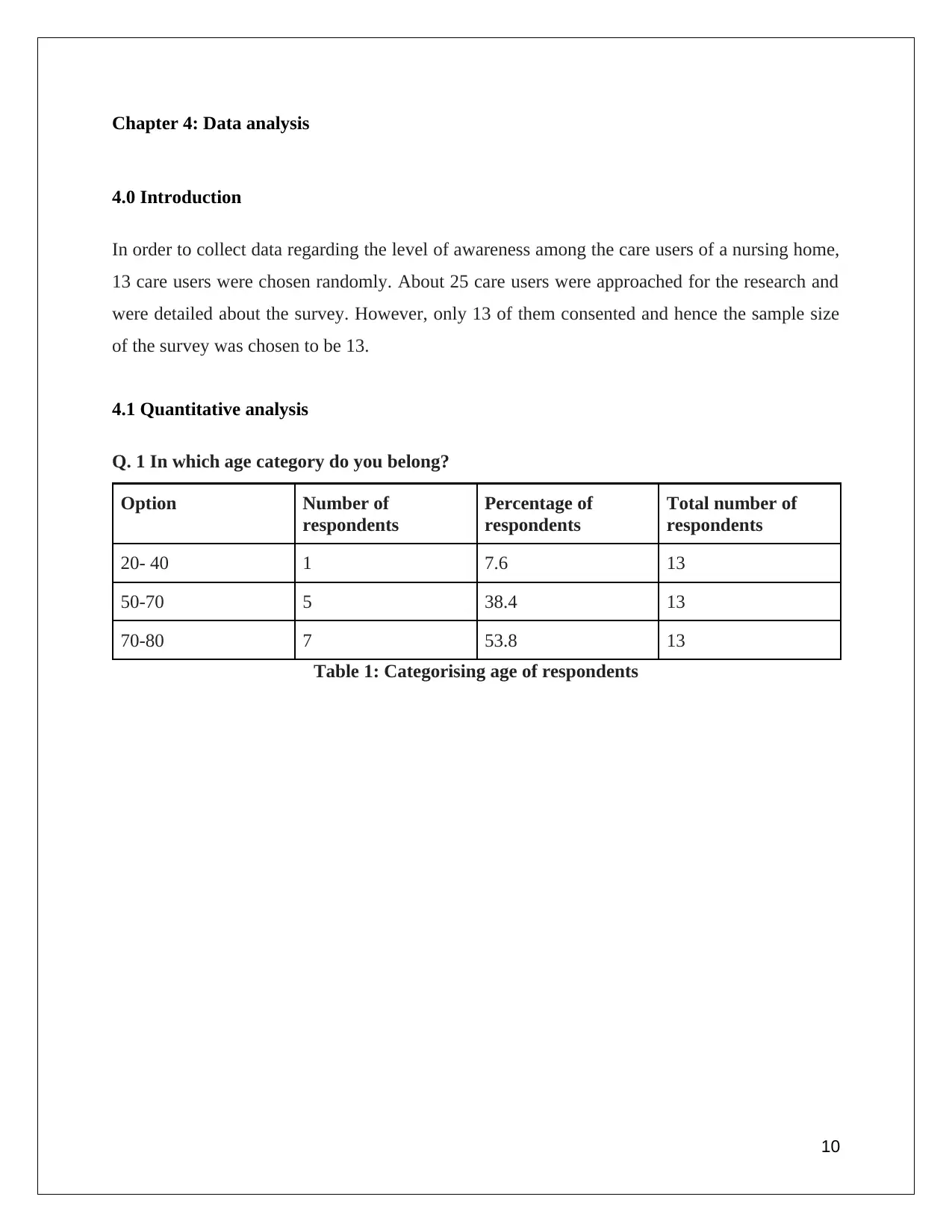
Chapter 4: Data analysis
4.0 Introduction
In order to collect data regarding the level of awareness among the care users of a nursing home,
13 care users were chosen randomly. About 25 care users were approached for the research and
were detailed about the survey. However, only 13 of them consented and hence the sample size
of the survey was chosen to be 13.
4.1 Quantitative analysis
Q. 1 In which age category do you belong?
Option Number of
respondents
Percentage of
respondents
Total number of
respondents
20- 40 1 7.6 13
50-70 5 38.4 13
70-80 7 53.8 13
Table 1: Categorising age of respondents
10
4.0 Introduction
In order to collect data regarding the level of awareness among the care users of a nursing home,
13 care users were chosen randomly. About 25 care users were approached for the research and
were detailed about the survey. However, only 13 of them consented and hence the sample size
of the survey was chosen to be 13.
4.1 Quantitative analysis
Q. 1 In which age category do you belong?
Option Number of
respondents
Percentage of
respondents
Total number of
respondents
20- 40 1 7.6 13
50-70 5 38.4 13
70-80 7 53.8 13
Table 1: Categorising age of respondents
10
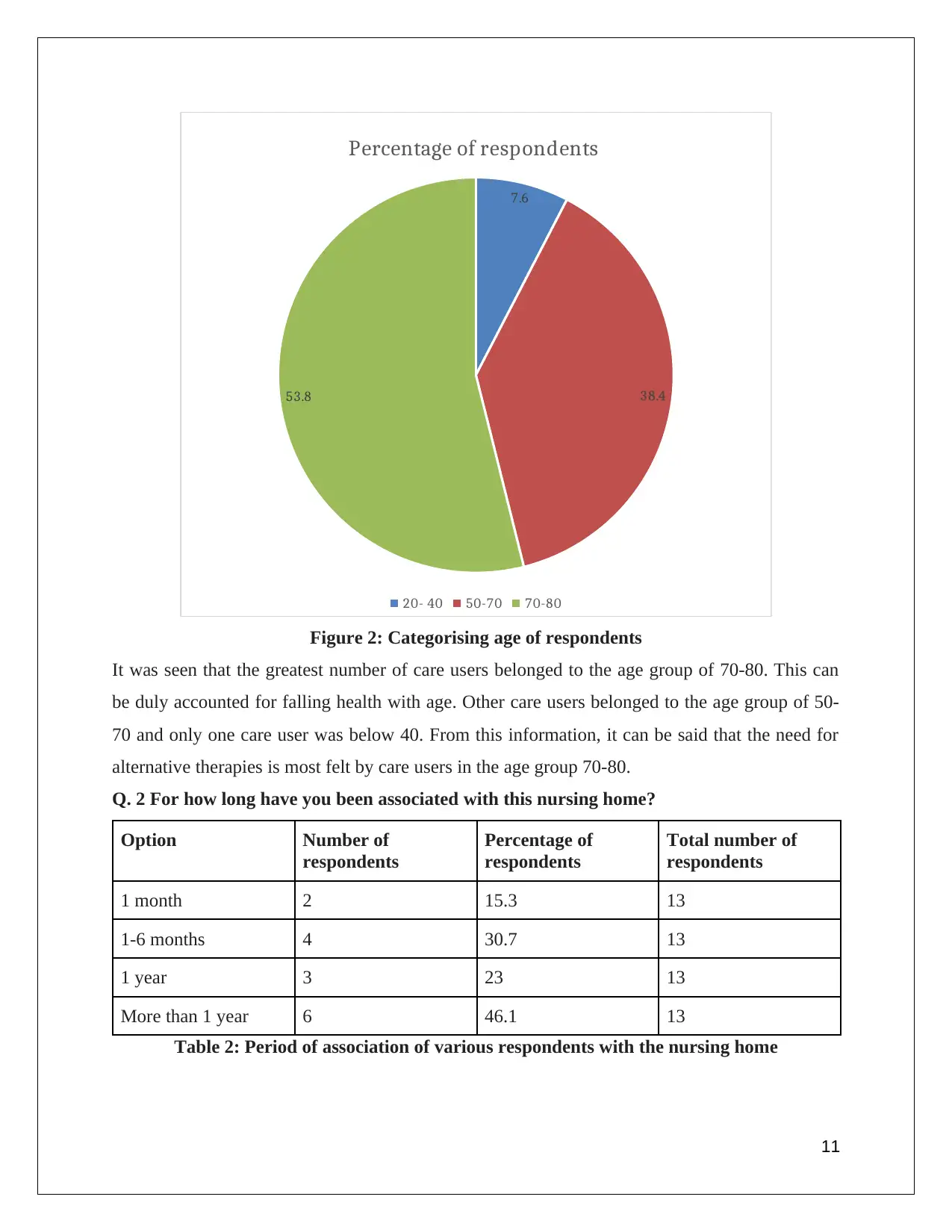
7.6
38.453.8
Percentage of respondents
20- 40 50-70 70-80
Figure 2: Categorising age of respondents
It was seen that the greatest number of care users belonged to the age group of 70-80. This can
be duly accounted for falling health with age. Other care users belonged to the age group of 50-
70 and only one care user was below 40. From this information, it can be said that the need for
alternative therapies is most felt by care users in the age group 70-80.
Q. 2 For how long have you been associated with this nursing home?
Option Number of
respondents
Percentage of
respondents
Total number of
respondents
1 month 2 15.3 13
1-6 months 4 30.7 13
1 year 3 23 13
More than 1 year 6 46.1 13
Table 2: Period of association of various respondents with the nursing home
11
38.453.8
Percentage of respondents
20- 40 50-70 70-80
Figure 2: Categorising age of respondents
It was seen that the greatest number of care users belonged to the age group of 70-80. This can
be duly accounted for falling health with age. Other care users belonged to the age group of 50-
70 and only one care user was below 40. From this information, it can be said that the need for
alternative therapies is most felt by care users in the age group 70-80.
Q. 2 For how long have you been associated with this nursing home?
Option Number of
respondents
Percentage of
respondents
Total number of
respondents
1 month 2 15.3 13
1-6 months 4 30.7 13
1 year 3 23 13
More than 1 year 6 46.1 13
Table 2: Period of association of various respondents with the nursing home
11
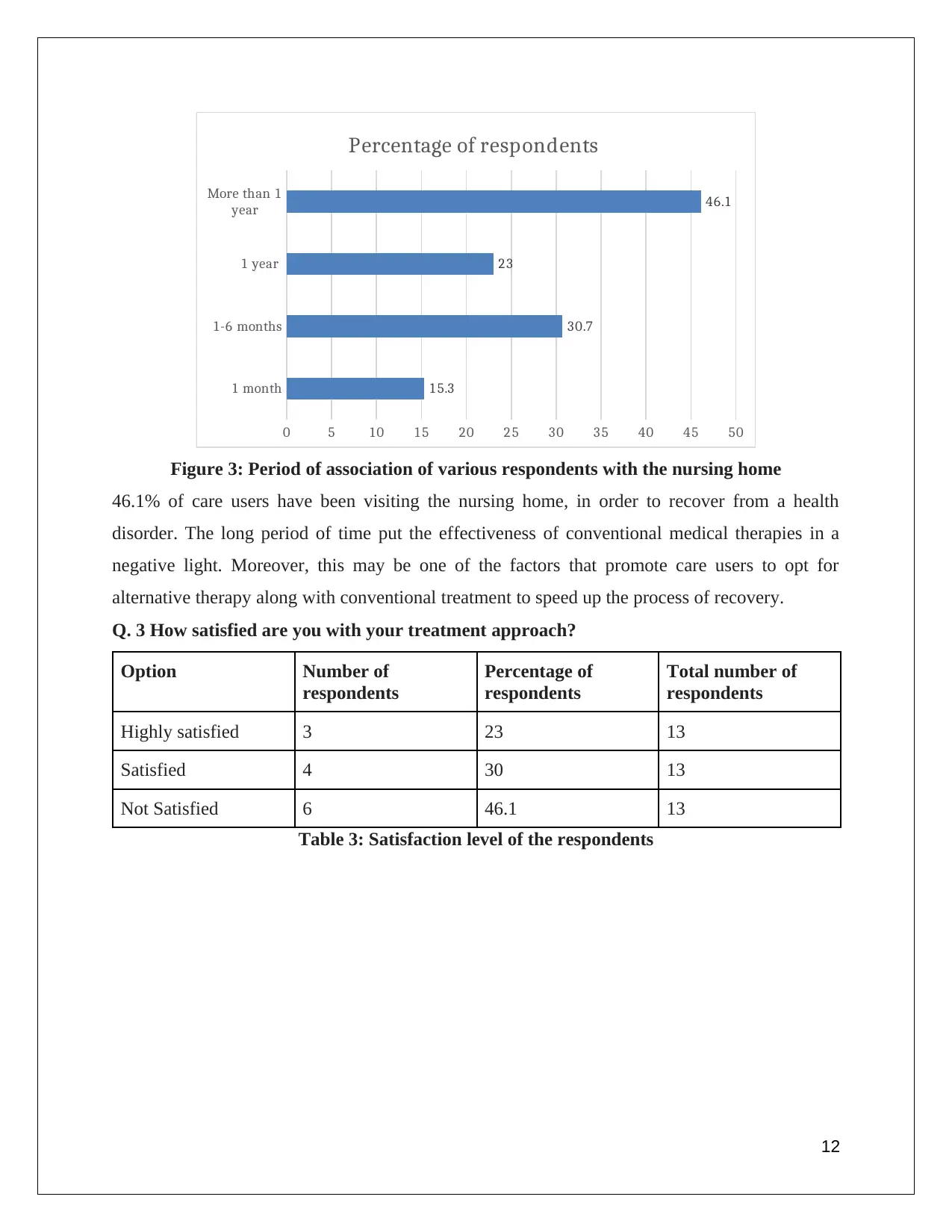
1 month
1-6 months
1 year
More than 1
year
0 5 10 15 20 25 30 35 40 45 50
15.3
30.7
23
46.1
Percentage of respondents
Figure 3: Period of association of various respondents with the nursing home
46.1% of care users have been visiting the nursing home, in order to recover from a health
disorder. The long period of time put the effectiveness of conventional medical therapies in a
negative light. Moreover, this may be one of the factors that promote care users to opt for
alternative therapy along with conventional treatment to speed up the process of recovery.
Q. 3 How satisfied are you with your treatment approach?
Option Number of
respondents
Percentage of
respondents
Total number of
respondents
Highly satisfied 3 23 13
Satisfied 4 30 13
Not Satisfied 6 46.1 13
Table 3: Satisfaction level of the respondents
12
1-6 months
1 year
More than 1
year
0 5 10 15 20 25 30 35 40 45 50
15.3
30.7
23
46.1
Percentage of respondents
Figure 3: Period of association of various respondents with the nursing home
46.1% of care users have been visiting the nursing home, in order to recover from a health
disorder. The long period of time put the effectiveness of conventional medical therapies in a
negative light. Moreover, this may be one of the factors that promote care users to opt for
alternative therapy along with conventional treatment to speed up the process of recovery.
Q. 3 How satisfied are you with your treatment approach?
Option Number of
respondents
Percentage of
respondents
Total number of
respondents
Highly satisfied 3 23 13
Satisfied 4 30 13
Not Satisfied 6 46.1 13
Table 3: Satisfaction level of the respondents
12
Paraphrase This Document
Need a fresh take? Get an instant paraphrase of this document with our AI Paraphraser
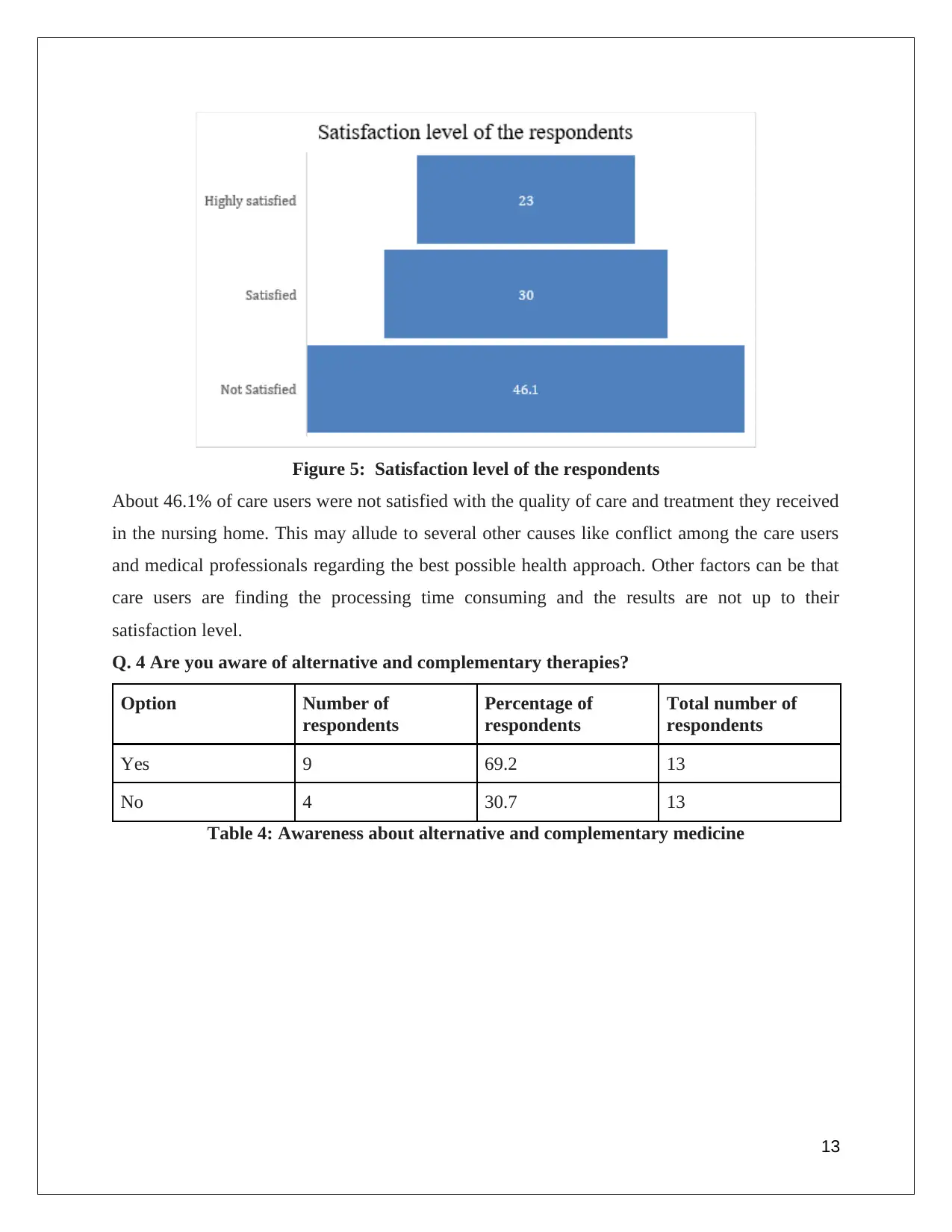
Figure 5: Satisfaction level of the respondents
About 46.1% of care users were not satisfied with the quality of care and treatment they received
in the nursing home. This may allude to several other causes like conflict among the care users
and medical professionals regarding the best possible health approach. Other factors can be that
care users are finding the processing time consuming and the results are not up to their
satisfaction level.
Q. 4 Are you aware of alternative and complementary therapies?
Option Number of
respondents
Percentage of
respondents
Total number of
respondents
Yes 9 69.2 13
No 4 30.7 13
Table 4: Awareness about alternative and complementary medicine
13
About 46.1% of care users were not satisfied with the quality of care and treatment they received
in the nursing home. This may allude to several other causes like conflict among the care users
and medical professionals regarding the best possible health approach. Other factors can be that
care users are finding the processing time consuming and the results are not up to their
satisfaction level.
Q. 4 Are you aware of alternative and complementary therapies?
Option Number of
respondents
Percentage of
respondents
Total number of
respondents
Yes 9 69.2 13
No 4 30.7 13
Table 4: Awareness about alternative and complementary medicine
13
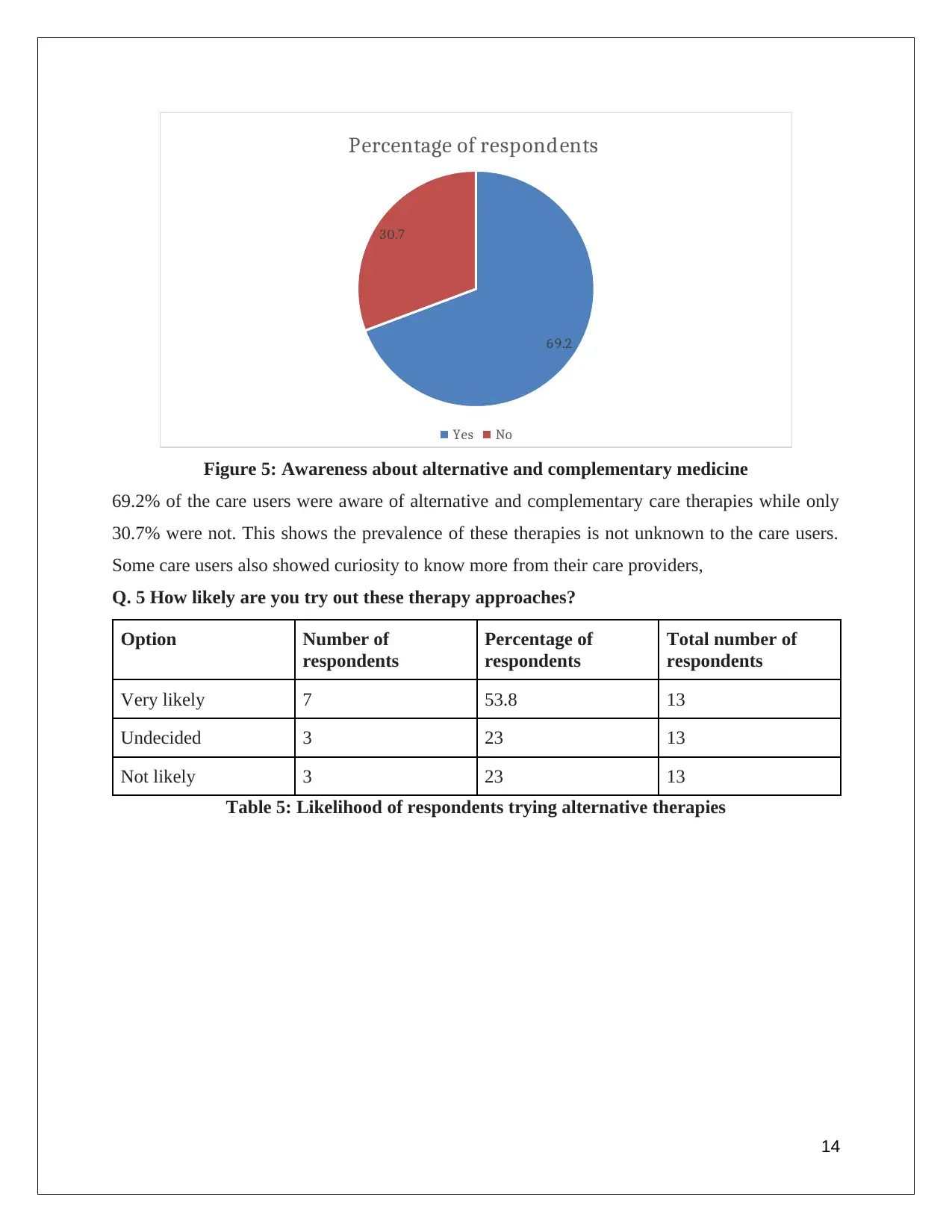
69.2
30.7
Percentage of respondents
Yes No
Figure 5: Awareness about alternative and complementary medicine
69.2% of the care users were aware of alternative and complementary care therapies while only
30.7% were not. This shows the prevalence of these therapies is not unknown to the care users.
Some care users also showed curiosity to know more from their care providers,
Q. 5 How likely are you try out these therapy approaches?
Option Number of
respondents
Percentage of
respondents
Total number of
respondents
Very likely 7 53.8 13
Undecided 3 23 13
Not likely 3 23 13
Table 5: Likelihood of respondents trying alternative therapies
14
30.7
Percentage of respondents
Yes No
Figure 5: Awareness about alternative and complementary medicine
69.2% of the care users were aware of alternative and complementary care therapies while only
30.7% were not. This shows the prevalence of these therapies is not unknown to the care users.
Some care users also showed curiosity to know more from their care providers,
Q. 5 How likely are you try out these therapy approaches?
Option Number of
respondents
Percentage of
respondents
Total number of
respondents
Very likely 7 53.8 13
Undecided 3 23 13
Not likely 3 23 13
Table 5: Likelihood of respondents trying alternative therapies
14
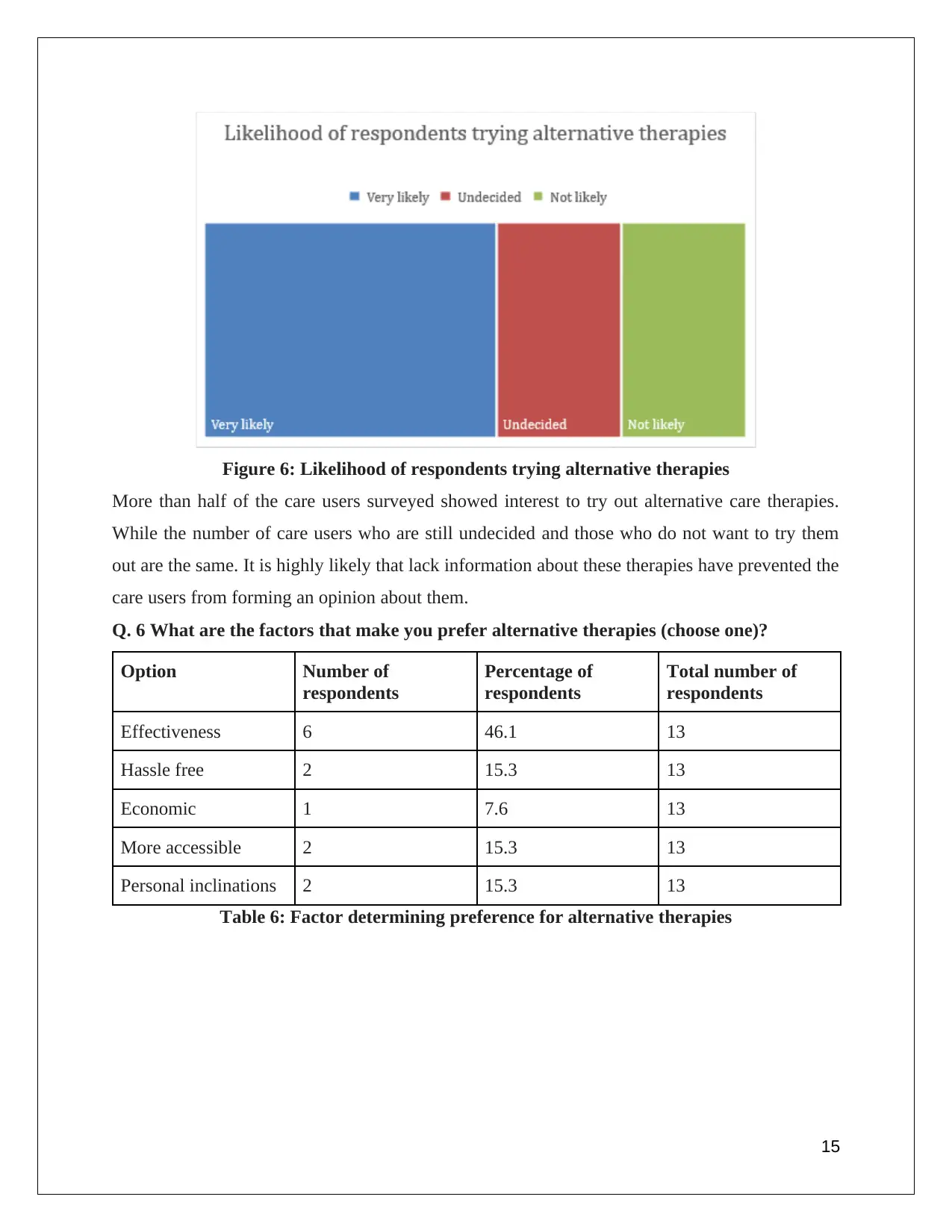
Figure 6: Likelihood of respondents trying alternative therapies
More than half of the care users surveyed showed interest to try out alternative care therapies.
While the number of care users who are still undecided and those who do not want to try them
out are the same. It is highly likely that lack information about these therapies have prevented the
care users from forming an opinion about them.
Q. 6 What are the factors that make you prefer alternative therapies (choose one)?
Option Number of
respondents
Percentage of
respondents
Total number of
respondents
Effectiveness 6 46.1 13
Hassle free 2 15.3 13
Economic 1 7.6 13
More accessible 2 15.3 13
Personal inclinations 2 15.3 13
Table 6: Factor determining preference for alternative therapies
15
More than half of the care users surveyed showed interest to try out alternative care therapies.
While the number of care users who are still undecided and those who do not want to try them
out are the same. It is highly likely that lack information about these therapies have prevented the
care users from forming an opinion about them.
Q. 6 What are the factors that make you prefer alternative therapies (choose one)?
Option Number of
respondents
Percentage of
respondents
Total number of
respondents
Effectiveness 6 46.1 13
Hassle free 2 15.3 13
Economic 1 7.6 13
More accessible 2 15.3 13
Personal inclinations 2 15.3 13
Table 6: Factor determining preference for alternative therapies
15
Secure Best Marks with AI Grader
Need help grading? Try our AI Grader for instant feedback on your assignments.
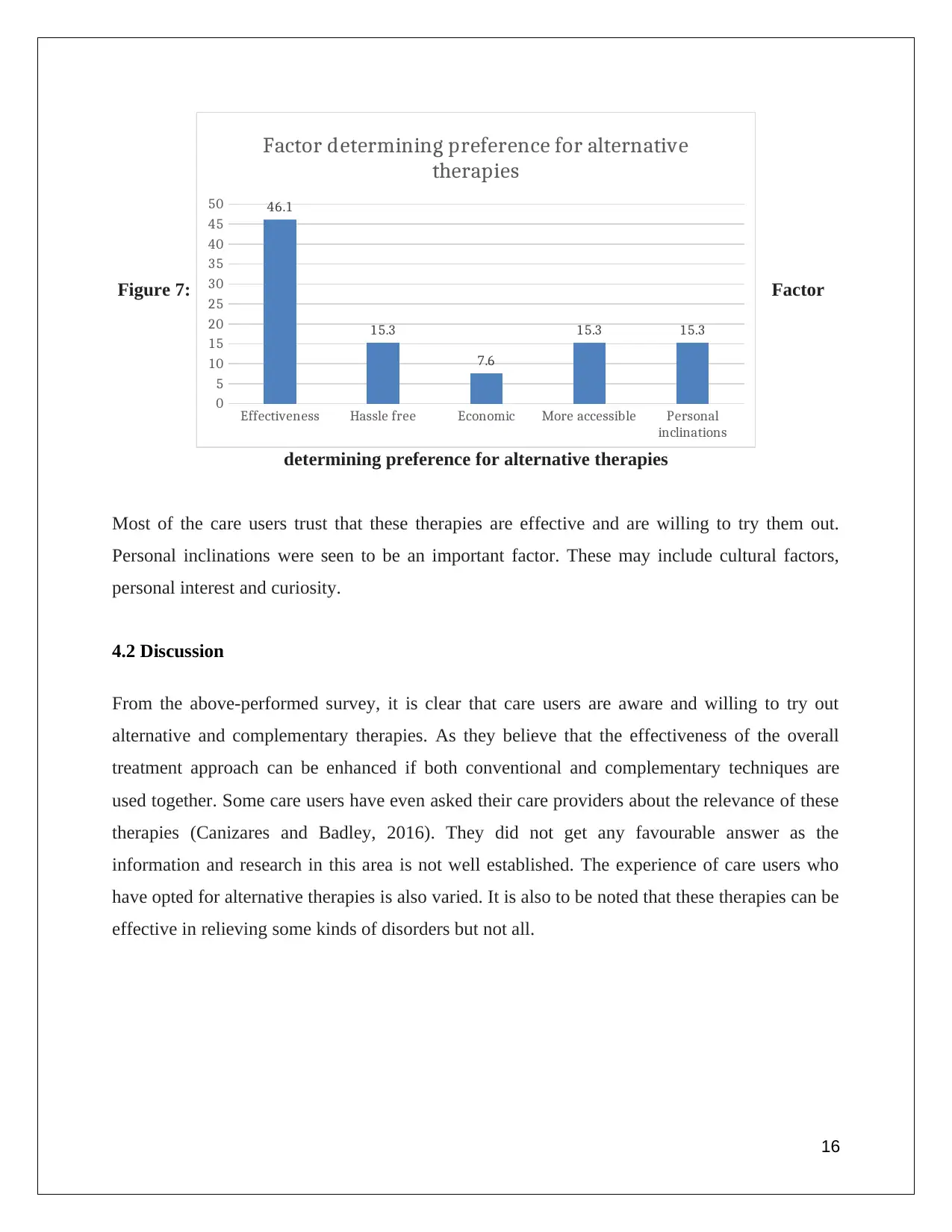
Figure 7: Factor
determining preference for alternative therapies
Most of the care users trust that these therapies are effective and are willing to try them out.
Personal inclinations were seen to be an important factor. These may include cultural factors,
personal interest and curiosity.
4.2 Discussion
From the above-performed survey, it is clear that care users are aware and willing to try out
alternative and complementary therapies. As they believe that the effectiveness of the overall
treatment approach can be enhanced if both conventional and complementary techniques are
used together. Some care users have even asked their care providers about the relevance of these
therapies (Canizares and Badley, 2016). They did not get any favourable answer as the
information and research in this area is not well established. The experience of care users who
have opted for alternative therapies is also varied. It is also to be noted that these therapies can be
effective in relieving some kinds of disorders but not all.
16
Effectiveness Hassle free Economic More accessible Personal
inclinations
0
5
10
15
20
25
30
35
40
45
50 46.1
15.3
7.6
15.3 15.3
Factor determining preference for alternative
therapies
determining preference for alternative therapies
Most of the care users trust that these therapies are effective and are willing to try them out.
Personal inclinations were seen to be an important factor. These may include cultural factors,
personal interest and curiosity.
4.2 Discussion
From the above-performed survey, it is clear that care users are aware and willing to try out
alternative and complementary therapies. As they believe that the effectiveness of the overall
treatment approach can be enhanced if both conventional and complementary techniques are
used together. Some care users have even asked their care providers about the relevance of these
therapies (Canizares and Badley, 2016). They did not get any favourable answer as the
information and research in this area is not well established. The experience of care users who
have opted for alternative therapies is also varied. It is also to be noted that these therapies can be
effective in relieving some kinds of disorders but not all.
16
Effectiveness Hassle free Economic More accessible Personal
inclinations
0
5
10
15
20
25
30
35
40
45
50 46.1
15.3
7.6
15.3 15.3
Factor determining preference for alternative
therapies
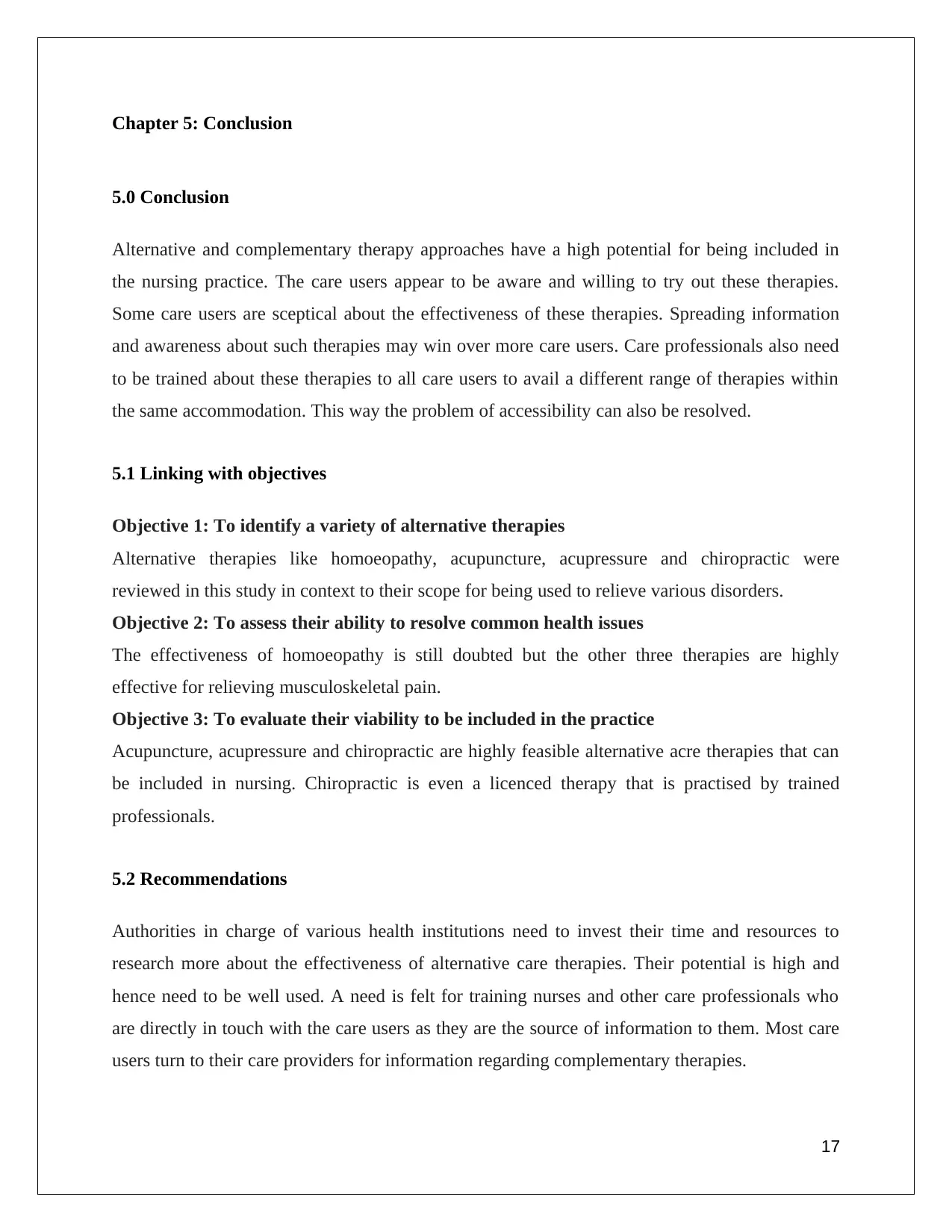
Chapter 5: Conclusion
5.0 Conclusion
Alternative and complementary therapy approaches have a high potential for being included in
the nursing practice. The care users appear to be aware and willing to try out these therapies.
Some care users are sceptical about the effectiveness of these therapies. Spreading information
and awareness about such therapies may win over more care users. Care professionals also need
to be trained about these therapies to all care users to avail a different range of therapies within
the same accommodation. This way the problem of accessibility can also be resolved.
5.1 Linking with objectives
Objective 1: To identify a variety of alternative therapies
Alternative therapies like homoeopathy, acupuncture, acupressure and chiropractic were
reviewed in this study in context to their scope for being used to relieve various disorders.
Objective 2: To assess their ability to resolve common health issues
The effectiveness of homoeopathy is still doubted but the other three therapies are highly
effective for relieving musculoskeletal pain.
Objective 3: To evaluate their viability to be included in the practice
Acupuncture, acupressure and chiropractic are highly feasible alternative acre therapies that can
be included in nursing. Chiropractic is even a licenced therapy that is practised by trained
professionals.
5.2 Recommendations
Authorities in charge of various health institutions need to invest their time and resources to
research more about the effectiveness of alternative care therapies. Their potential is high and
hence need to be well used. A need is felt for training nurses and other care professionals who
are directly in touch with the care users as they are the source of information to them. Most care
users turn to their care providers for information regarding complementary therapies.
17
5.0 Conclusion
Alternative and complementary therapy approaches have a high potential for being included in
the nursing practice. The care users appear to be aware and willing to try out these therapies.
Some care users are sceptical about the effectiveness of these therapies. Spreading information
and awareness about such therapies may win over more care users. Care professionals also need
to be trained about these therapies to all care users to avail a different range of therapies within
the same accommodation. This way the problem of accessibility can also be resolved.
5.1 Linking with objectives
Objective 1: To identify a variety of alternative therapies
Alternative therapies like homoeopathy, acupuncture, acupressure and chiropractic were
reviewed in this study in context to their scope for being used to relieve various disorders.
Objective 2: To assess their ability to resolve common health issues
The effectiveness of homoeopathy is still doubted but the other three therapies are highly
effective for relieving musculoskeletal pain.
Objective 3: To evaluate their viability to be included in the practice
Acupuncture, acupressure and chiropractic are highly feasible alternative acre therapies that can
be included in nursing. Chiropractic is even a licenced therapy that is practised by trained
professionals.
5.2 Recommendations
Authorities in charge of various health institutions need to invest their time and resources to
research more about the effectiveness of alternative care therapies. Their potential is high and
hence need to be well used. A need is felt for training nurses and other care professionals who
are directly in touch with the care users as they are the source of information to them. Most care
users turn to their care providers for information regarding complementary therapies.
17
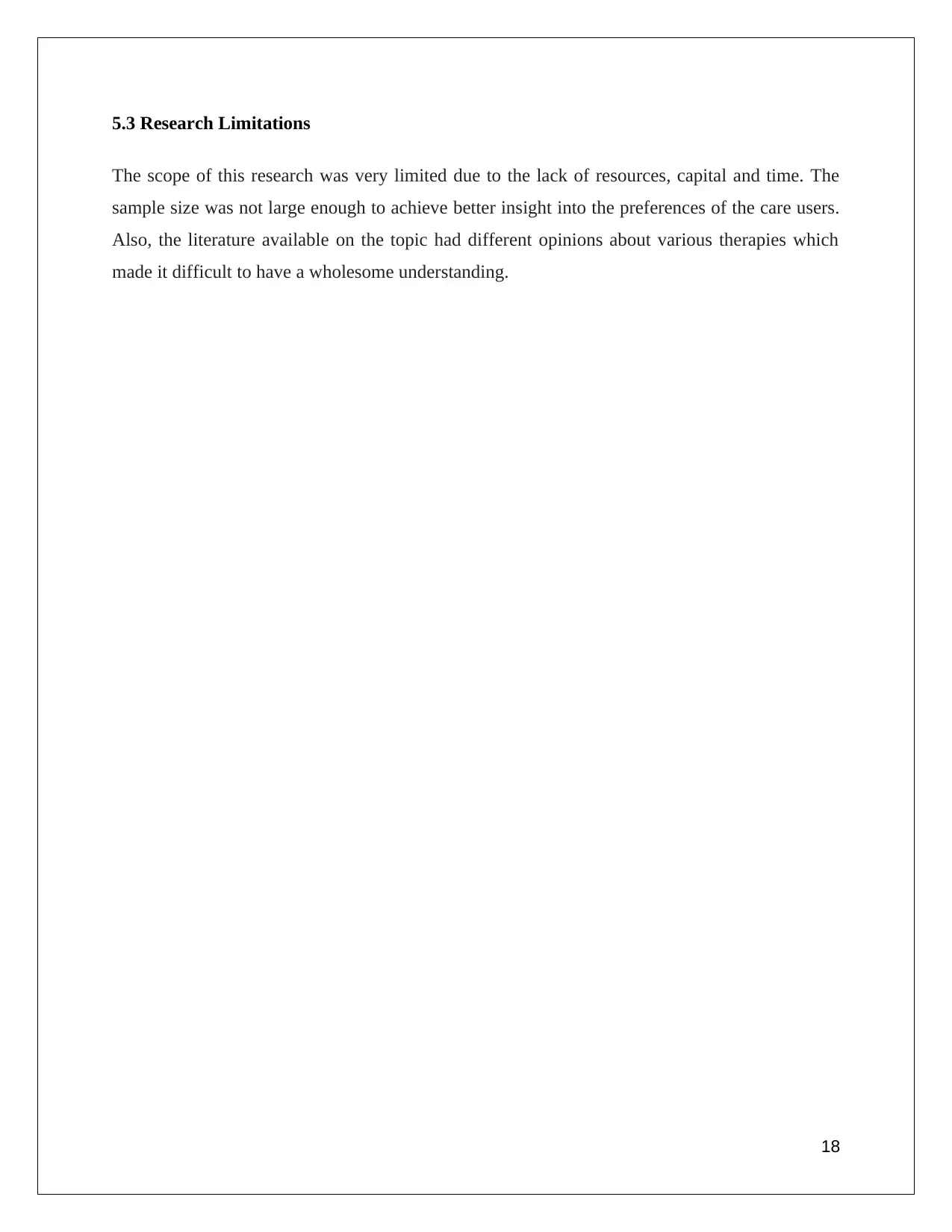
5.3 Research Limitations
The scope of this research was very limited due to the lack of resources, capital and time. The
sample size was not large enough to achieve better insight into the preferences of the care users.
Also, the literature available on the topic had different opinions about various therapies which
made it difficult to have a wholesome understanding.
18
The scope of this research was very limited due to the lack of resources, capital and time. The
sample size was not large enough to achieve better insight into the preferences of the care users.
Also, the literature available on the topic had different opinions about various therapies which
made it difficult to have a wholesome understanding.
18
Paraphrase This Document
Need a fresh take? Get an instant paraphrase of this document with our AI Paraphraser
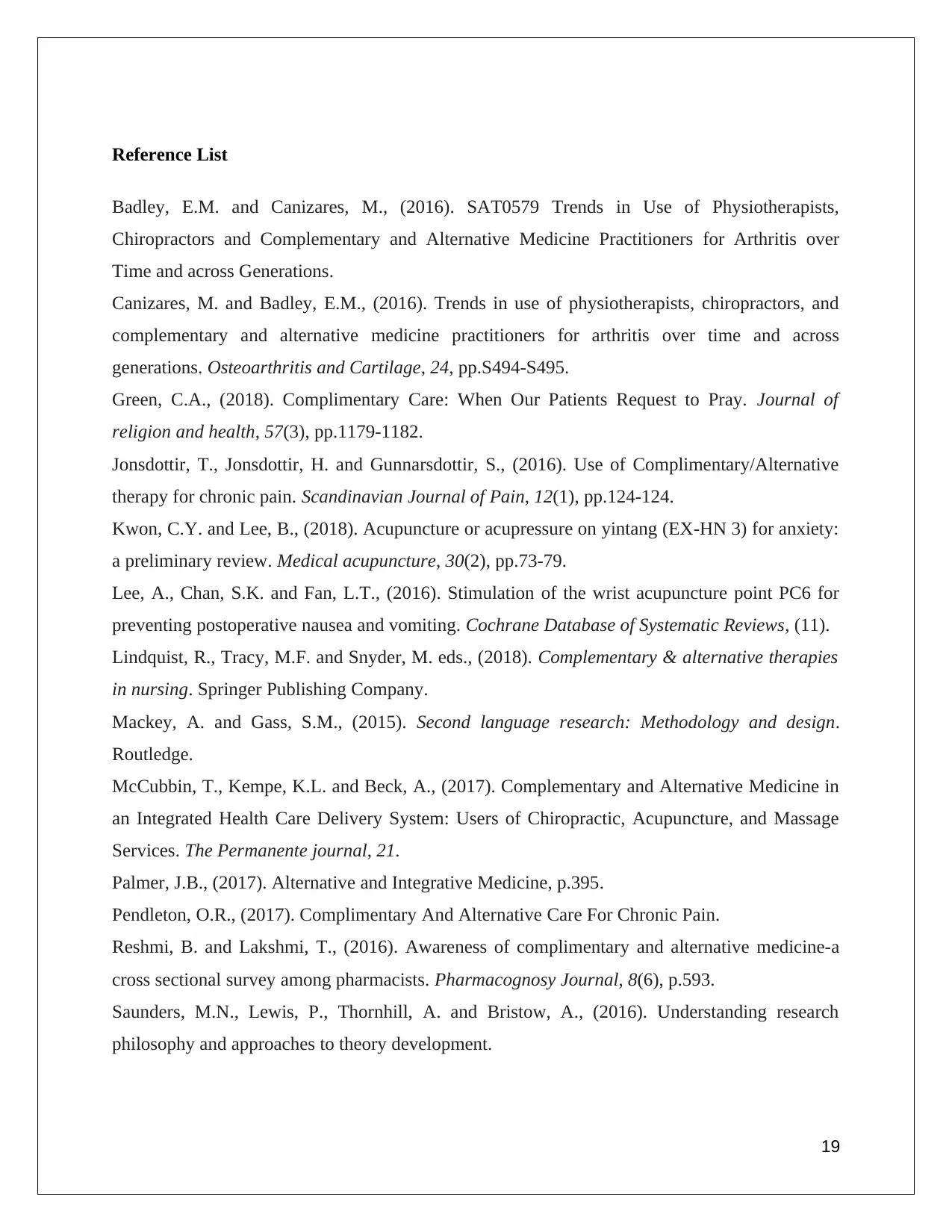
Reference List
Badley, E.M. and Canizares, M., (2016). SAT0579 Trends in Use of Physiotherapists,
Chiropractors and Complementary and Alternative Medicine Practitioners for Arthritis over
Time and across Generations.
Canizares, M. and Badley, E.M., (2016). Trends in use of physiotherapists, chiropractors, and
complementary and alternative medicine practitioners for arthritis over time and across
generations. Osteoarthritis and Cartilage, 24, pp.S494-S495.
Green, C.A., (2018). Complimentary Care: When Our Patients Request to Pray. Journal of
religion and health, 57(3), pp.1179-1182.
Jonsdottir, T., Jonsdottir, H. and Gunnarsdottir, S., (2016). Use of Complimentary/Alternative
therapy for chronic pain. Scandinavian Journal of Pain, 12(1), pp.124-124.
Kwon, C.Y. and Lee, B., (2018). Acupuncture or acupressure on yintang (EX-HN 3) for anxiety:
a preliminary review. Medical acupuncture, 30(2), pp.73-79.
Lee, A., Chan, S.K. and Fan, L.T., (2016). Stimulation of the wrist acupuncture point PC6 for
preventing postoperative nausea and vomiting. Cochrane Database of Systematic Reviews, (11).
Lindquist, R., Tracy, M.F. and Snyder, M. eds., (2018). Complementary & alternative therapies
in nursing. Springer Publishing Company.
Mackey, A. and Gass, S.M., (2015). Second language research: Methodology and design.
Routledge.
McCubbin, T., Kempe, K.L. and Beck, A., (2017). Complementary and Alternative Medicine in
an Integrated Health Care Delivery System: Users of Chiropractic, Acupuncture, and Massage
Services. The Permanente journal, 21.
Palmer, J.B., (2017). Alternative and Integrative Medicine, p.395.
Pendleton, O.R., (2017). Complimentary And Alternative Care For Chronic Pain.
Reshmi, B. and Lakshmi, T., (2016). Awareness of complimentary and alternative medicine-a
cross sectional survey among pharmacists. Pharmacognosy Journal, 8(6), p.593.
Saunders, M.N., Lewis, P., Thornhill, A. and Bristow, A., (2016). Understanding research
philosophy and approaches to theory development.
19
Badley, E.M. and Canizares, M., (2016). SAT0579 Trends in Use of Physiotherapists,
Chiropractors and Complementary and Alternative Medicine Practitioners for Arthritis over
Time and across Generations.
Canizares, M. and Badley, E.M., (2016). Trends in use of physiotherapists, chiropractors, and
complementary and alternative medicine practitioners for arthritis over time and across
generations. Osteoarthritis and Cartilage, 24, pp.S494-S495.
Green, C.A., (2018). Complimentary Care: When Our Patients Request to Pray. Journal of
religion and health, 57(3), pp.1179-1182.
Jonsdottir, T., Jonsdottir, H. and Gunnarsdottir, S., (2016). Use of Complimentary/Alternative
therapy for chronic pain. Scandinavian Journal of Pain, 12(1), pp.124-124.
Kwon, C.Y. and Lee, B., (2018). Acupuncture or acupressure on yintang (EX-HN 3) for anxiety:
a preliminary review. Medical acupuncture, 30(2), pp.73-79.
Lee, A., Chan, S.K. and Fan, L.T., (2016). Stimulation of the wrist acupuncture point PC6 for
preventing postoperative nausea and vomiting. Cochrane Database of Systematic Reviews, (11).
Lindquist, R., Tracy, M.F. and Snyder, M. eds., (2018). Complementary & alternative therapies
in nursing. Springer Publishing Company.
Mackey, A. and Gass, S.M., (2015). Second language research: Methodology and design.
Routledge.
McCubbin, T., Kempe, K.L. and Beck, A., (2017). Complementary and Alternative Medicine in
an Integrated Health Care Delivery System: Users of Chiropractic, Acupuncture, and Massage
Services. The Permanente journal, 21.
Palmer, J.B., (2017). Alternative and Integrative Medicine, p.395.
Pendleton, O.R., (2017). Complimentary And Alternative Care For Chronic Pain.
Reshmi, B. and Lakshmi, T., (2016). Awareness of complimentary and alternative medicine-a
cross sectional survey among pharmacists. Pharmacognosy Journal, 8(6), p.593.
Saunders, M.N., Lewis, P., Thornhill, A. and Bristow, A., (2016). Understanding research
philosophy and approaches to theory development.
19
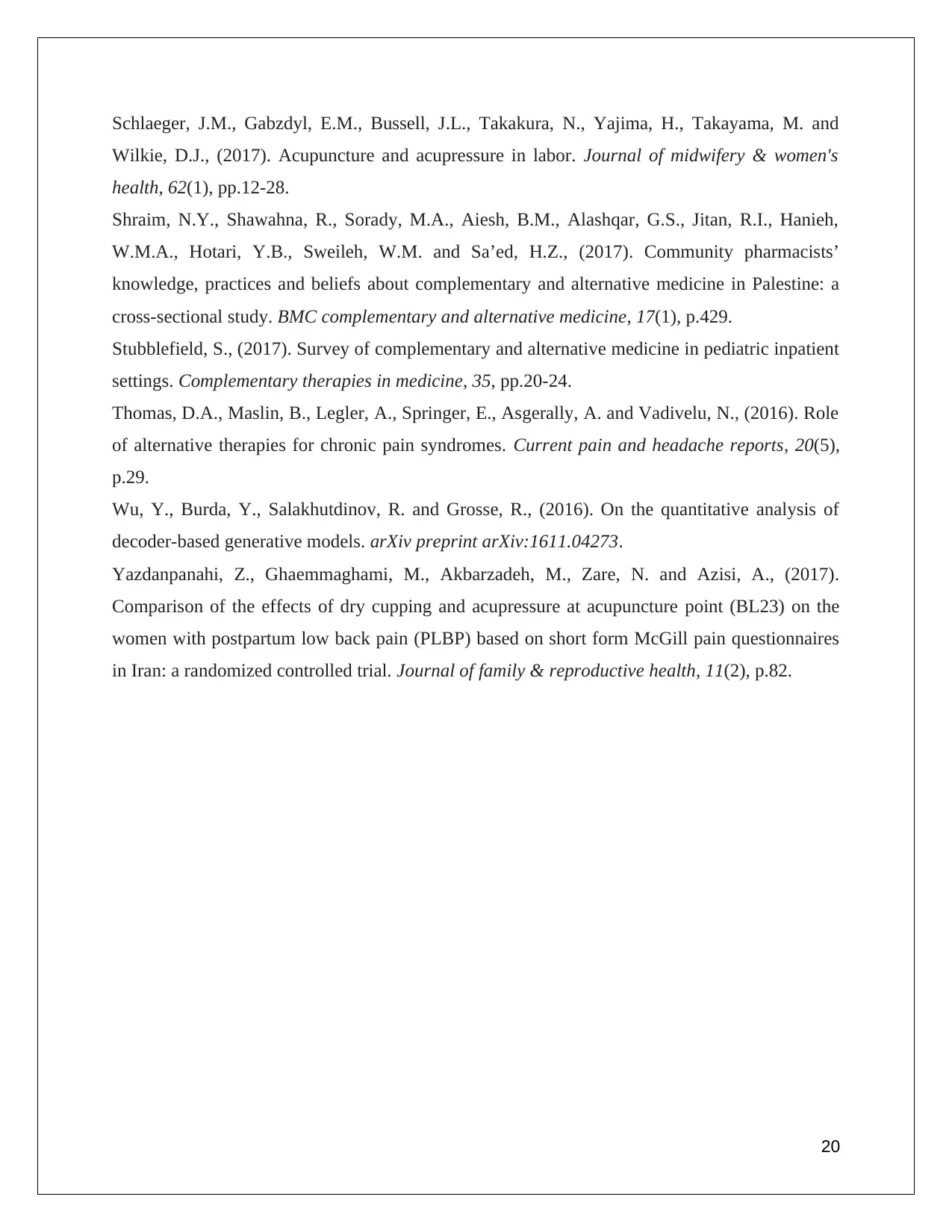
Schlaeger, J.M., Gabzdyl, E.M., Bussell, J.L., Takakura, N., Yajima, H., Takayama, M. and
Wilkie, D.J., (2017). Acupuncture and acupressure in labor. Journal of midwifery & women's
health, 62(1), pp.12-28.
Shraim, N.Y., Shawahna, R., Sorady, M.A., Aiesh, B.M., Alashqar, G.S., Jitan, R.I., Hanieh,
W.M.A., Hotari, Y.B., Sweileh, W.M. and Sa’ed, H.Z., (2017). Community pharmacists’
knowledge, practices and beliefs about complementary and alternative medicine in Palestine: a
cross-sectional study. BMC complementary and alternative medicine, 17(1), p.429.
Stubblefield, S., (2017). Survey of complementary and alternative medicine in pediatric inpatient
settings. Complementary therapies in medicine, 35, pp.20-24.
Thomas, D.A., Maslin, B., Legler, A., Springer, E., Asgerally, A. and Vadivelu, N., (2016). Role
of alternative therapies for chronic pain syndromes. Current pain and headache reports, 20(5),
p.29.
Wu, Y., Burda, Y., Salakhutdinov, R. and Grosse, R., (2016). On the quantitative analysis of
decoder-based generative models. arXiv preprint arXiv:1611.04273.
Yazdanpanahi, Z., Ghaemmaghami, M., Akbarzadeh, M., Zare, N. and Azisi, A., (2017).
Comparison of the effects of dry cupping and acupressure at acupuncture point (BL23) on the
women with postpartum low back pain (PLBP) based on short form McGill pain questionnaires
in Iran: a randomized controlled trial. Journal of family & reproductive health, 11(2), p.82.
20
Wilkie, D.J., (2017). Acupuncture and acupressure in labor. Journal of midwifery & women's
health, 62(1), pp.12-28.
Shraim, N.Y., Shawahna, R., Sorady, M.A., Aiesh, B.M., Alashqar, G.S., Jitan, R.I., Hanieh,
W.M.A., Hotari, Y.B., Sweileh, W.M. and Sa’ed, H.Z., (2017). Community pharmacists’
knowledge, practices and beliefs about complementary and alternative medicine in Palestine: a
cross-sectional study. BMC complementary and alternative medicine, 17(1), p.429.
Stubblefield, S., (2017). Survey of complementary and alternative medicine in pediatric inpatient
settings. Complementary therapies in medicine, 35, pp.20-24.
Thomas, D.A., Maslin, B., Legler, A., Springer, E., Asgerally, A. and Vadivelu, N., (2016). Role
of alternative therapies for chronic pain syndromes. Current pain and headache reports, 20(5),
p.29.
Wu, Y., Burda, Y., Salakhutdinov, R. and Grosse, R., (2016). On the quantitative analysis of
decoder-based generative models. arXiv preprint arXiv:1611.04273.
Yazdanpanahi, Z., Ghaemmaghami, M., Akbarzadeh, M., Zare, N. and Azisi, A., (2017).
Comparison of the effects of dry cupping and acupressure at acupuncture point (BL23) on the
women with postpartum low back pain (PLBP) based on short form McGill pain questionnaires
in Iran: a randomized controlled trial. Journal of family & reproductive health, 11(2), p.82.
20
1 out of 21
Related Documents
Your All-in-One AI-Powered Toolkit for Academic Success.
+13062052269
info@desklib.com
Available 24*7 on WhatsApp / Email
![[object Object]](/_next/static/media/star-bottom.7253800d.svg)
Unlock your academic potential
© 2024 | Zucol Services PVT LTD | All rights reserved.





